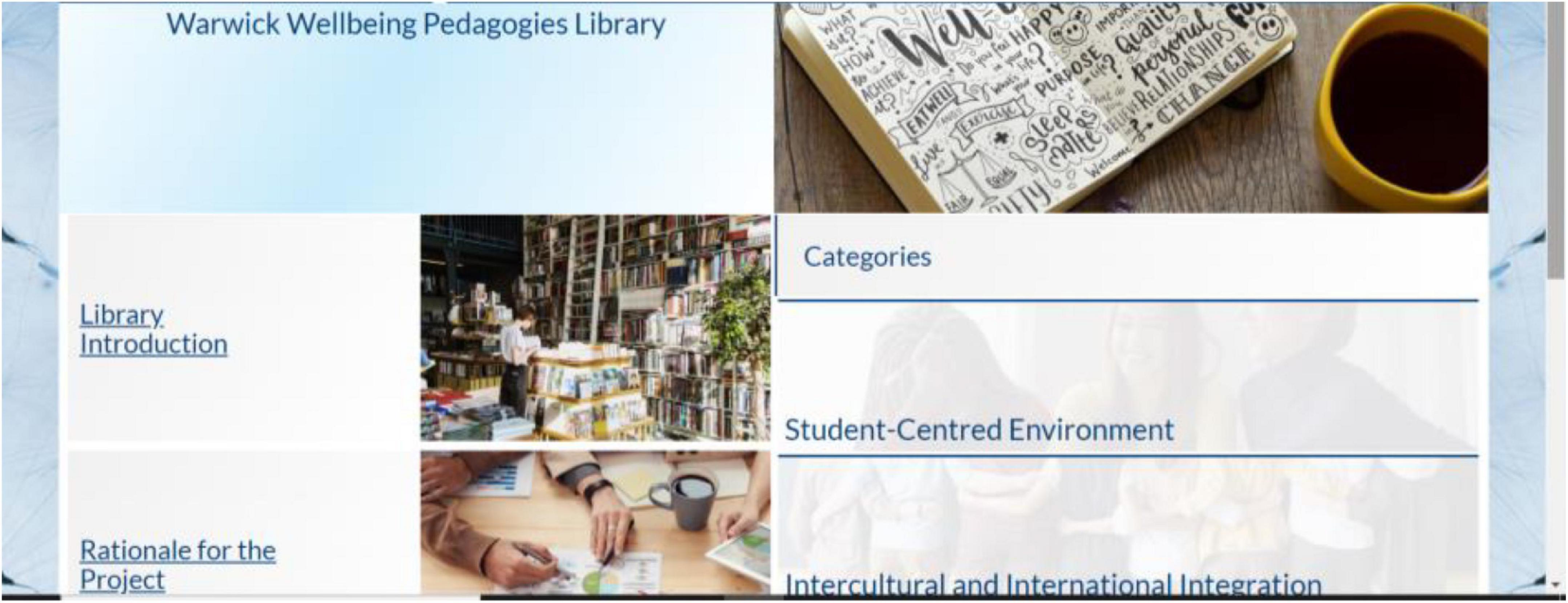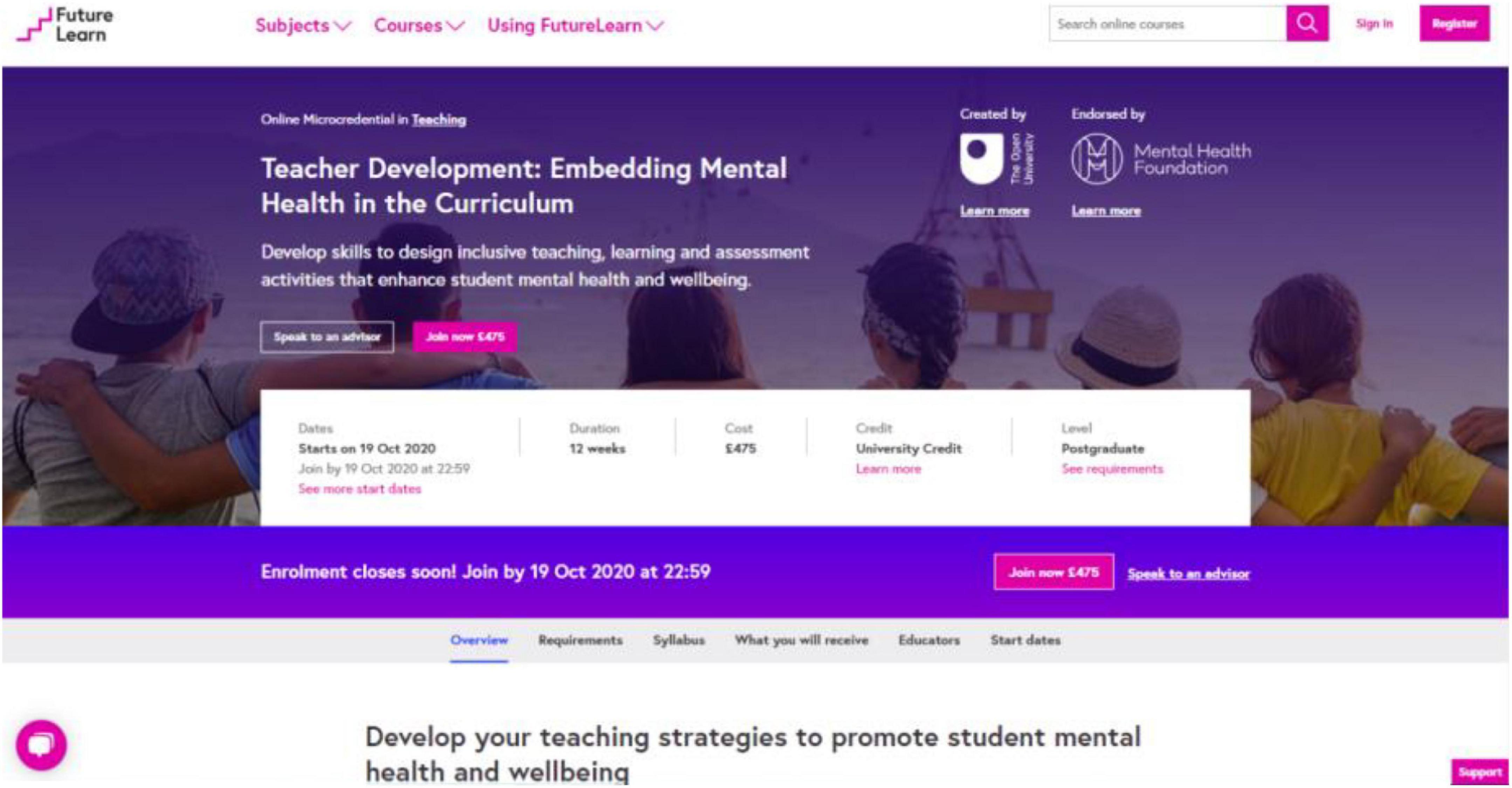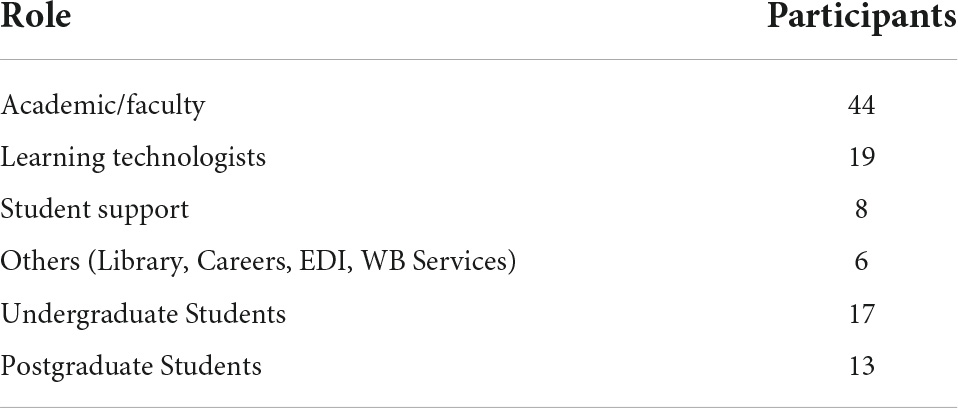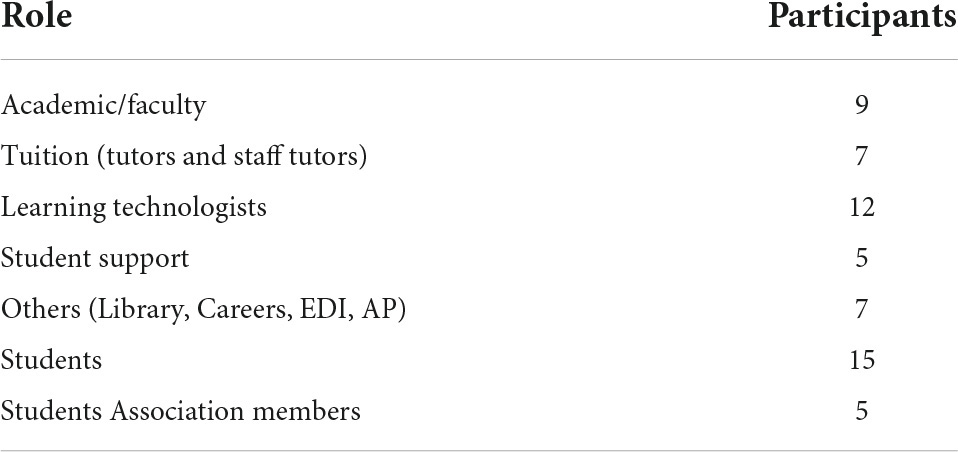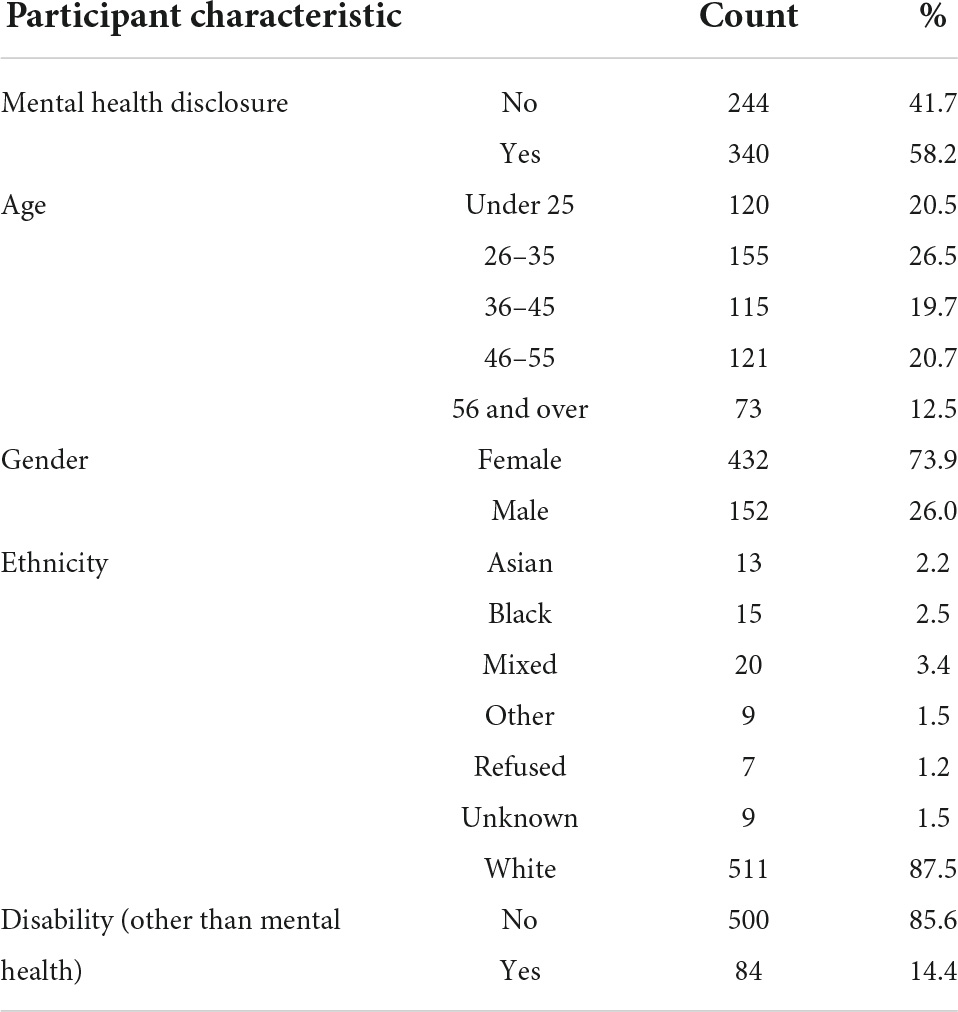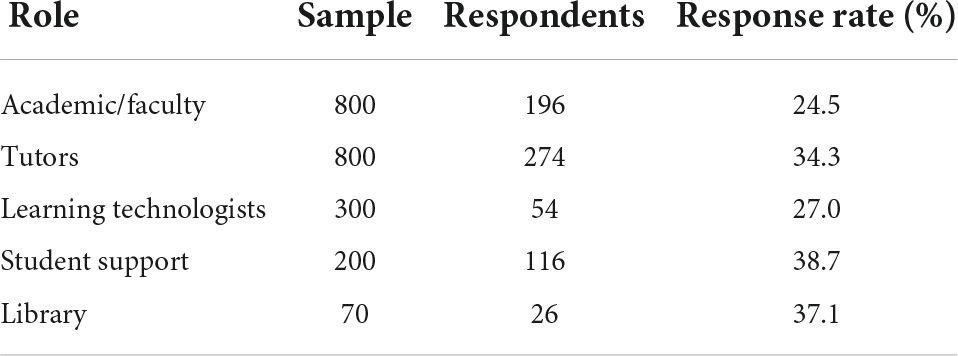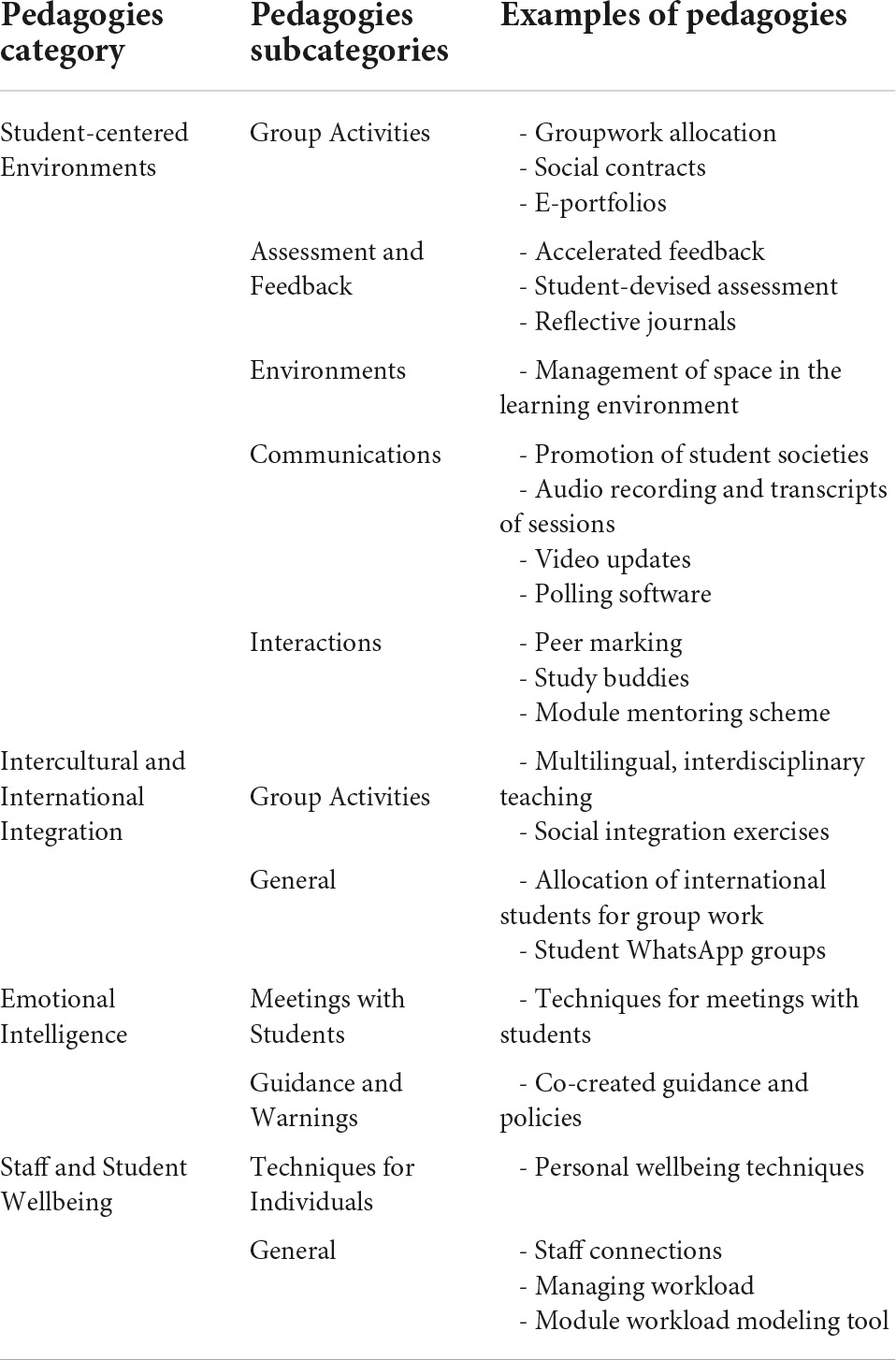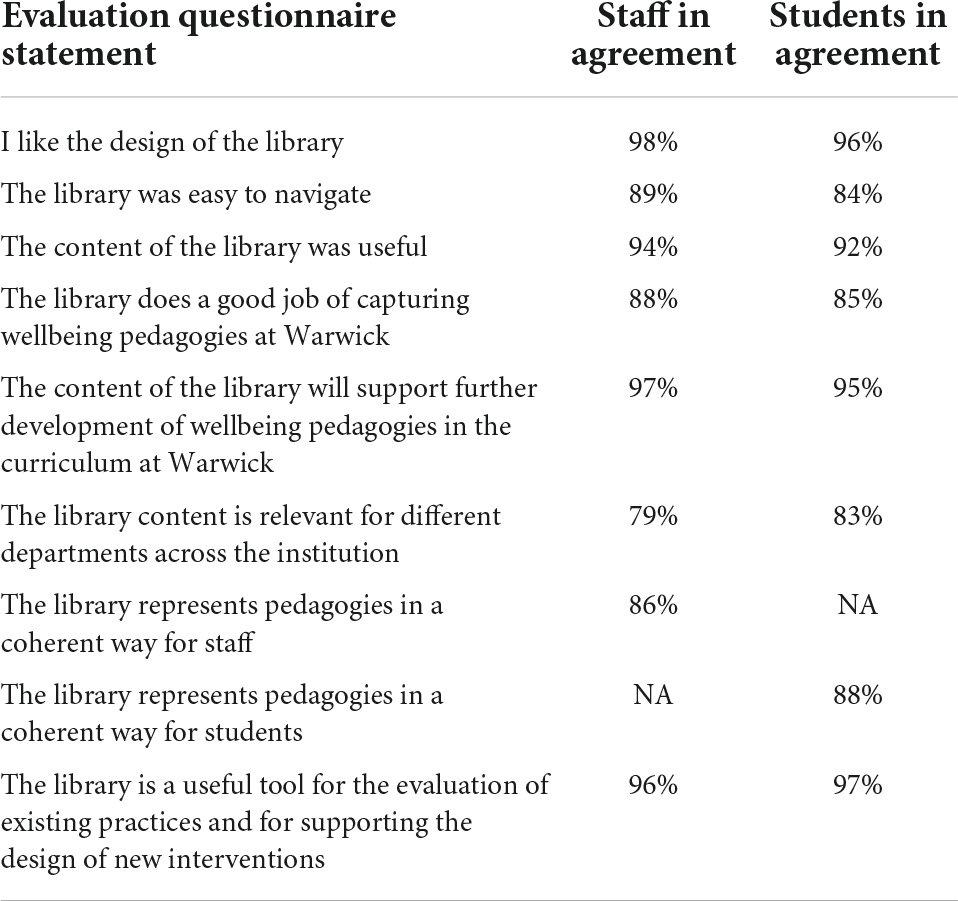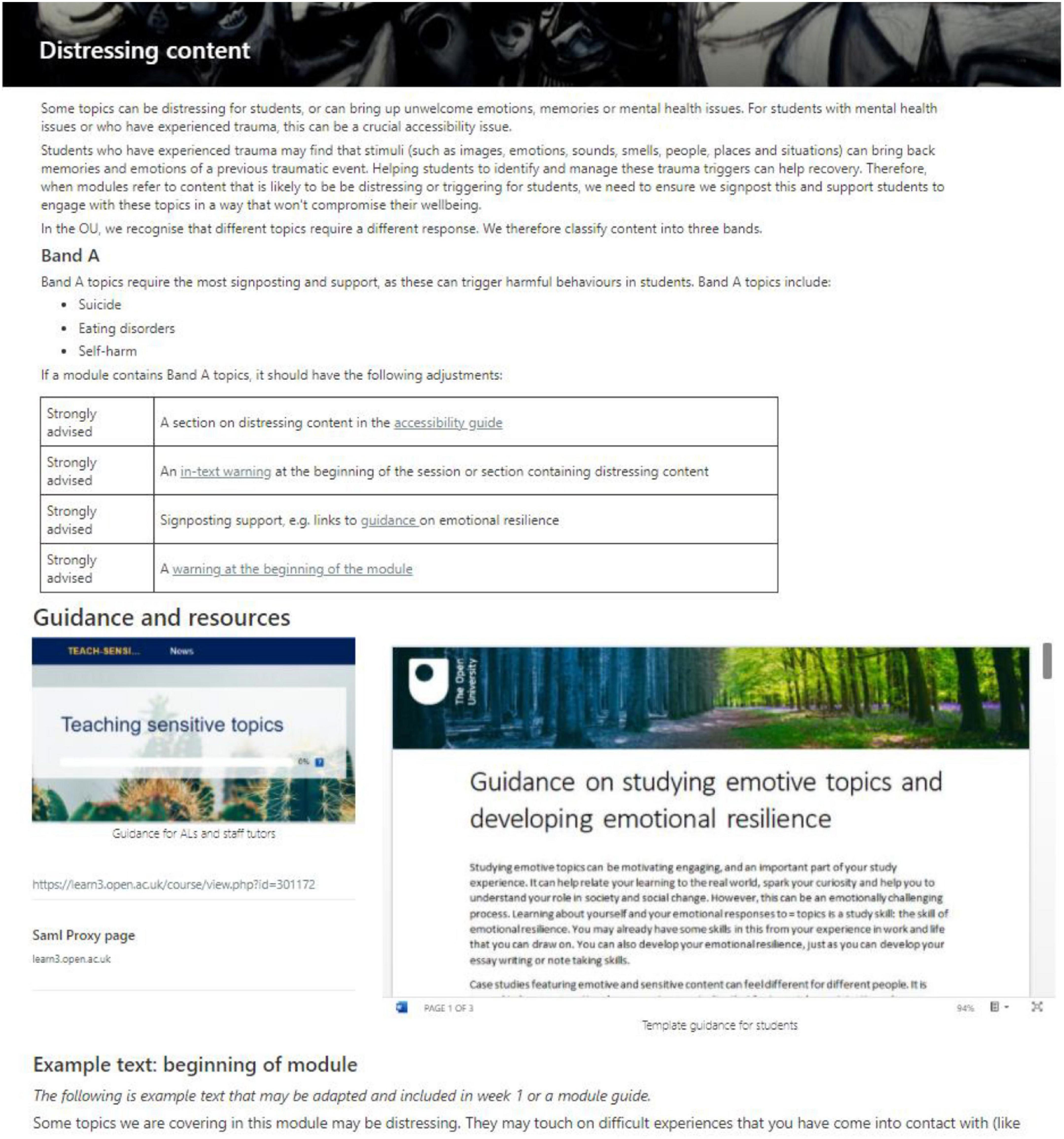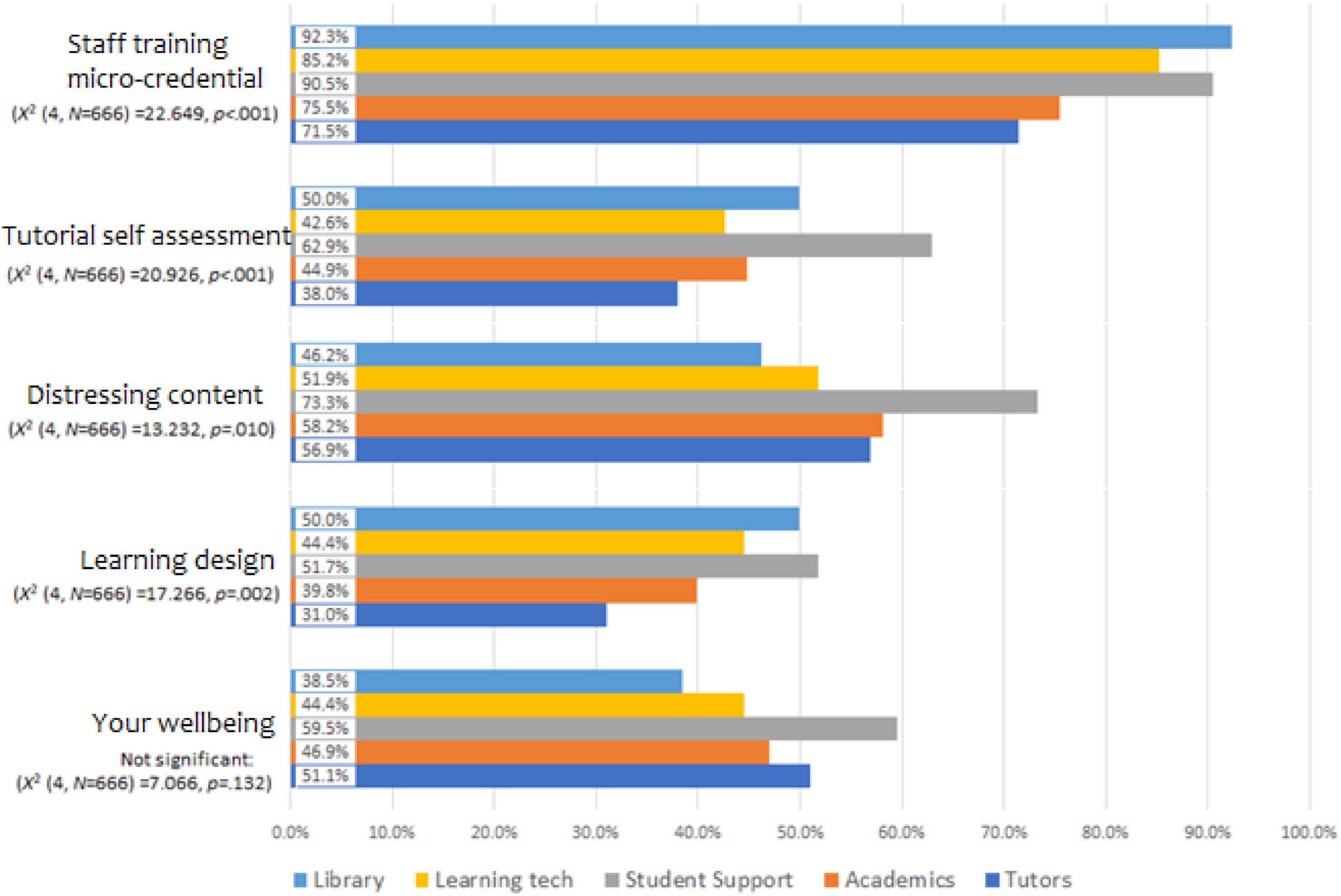- 1Faculty of Learning and Teaching, Arden University, Coventry, United Kingdom
- 2Institute of Educational Technology, The Open University, Milton Keynes, United Kingdom
- 3Institute for Advanced Teaching and Learning, University of Warwick, Coventry, United Kingdom
- 4Department of Psychology, University of Warwick, Coventry, United Kingdom
Student mental health and wellbeing are critical topics in higher education. In response to broader societal shifts in thinking around mental health and wellbeing, there are calls for universities to take a more proactive and holistic approach, working in partnership with students to embed mental wellbeing throughout learning, tuition and curricula. This paper presents two participatory projects from different United Kingdom higher education institutions, both of which took holistic, proactive and inclusive approaches toward supporting student mental wellbeing in higher education, using online and technology-based approaches. The first project is the digital “Wellbeing Pedagogies Library” at the University of Warwick, a digital repository co-designed with students to foster the sharing of pedagogical practices that support student wellbeing, and to offer a practical support to students and staff who want to create and/or sustain wellbeing-inducing teaching and learning environments. The second project is the “Mental Wellbeing in Distance Learning” project at the Open University, which piloted five digital subprojects, led by different practitioners in partnership with students, aiming to address barriers to wellbeing in different aspects of distance learning. This paper presents the participatory methods and approaches from each project, explores stakeholders’ perceptions of the value that participatory approaches added to the projects, and comparatively evaluates the projects’ outcomes in order to draw conclusions that can inform future participatory research. In doing so, it explores different types of participatory approaches that can be taken in different contexts, and how terms such as “holistic,” “proactive,” and “inclusive” may be interpreted and applied in practice. Drawing on the findings, it posits that participatory approaches and partnerships with students should be considered a priority when designing digital resources, interventions and solutions to support student mental wellbeing.
Introduction
Recent years have brought increasing recognition of the role universities need to play in supporting student mental health and wellbeing. They have brought increased sector awareness and dialogue around student mental health, with more and more sector bodies publishing reports and calls to action (Hughes and Spanner, 2019; Universities, 2020), and with requirements from sector regulators for institutions to take action to close degree outcome gaps (Office for Students, 2019). This in turn has brought increased activity in institutions, with myriad published studies and interventions on supporting student wellbeing. However, these interventions and studies are predominantly designed and conducted by small teams of university staff, with students as subjects; there have been very few studies or interventions that follow participatory approaches or feature partnerships with students throughout (Winzer et al., 2018).
This paper explores the participatory approaches adopted in two independent projects aiming to embed mental wellbeing in higher education. Using a comparative evaluation approach, it explores different participatory methods and highlights common themes of value and benefit brought to the projects by the use of participatory approaches. First, however, we review the literature relating to student mental health and wellbeing in higher education.
Student mental health and wellbeing in higher education
Research has consistently shown that mental health can have a significant impact on students’ likelihood of success in higher education. Students experiencing mental health difficulties are less likely to complete and/or pass a course or module (Mojtabai et al., 2015; Richardson, 2015), more likely to drop out of university (Brown, 2016), and less likely to attain higher grades (Eisenberg et al., 2009; Office for Students, 2019). Furthermore, studies suggest that higher education may actively affect students’ mental health. In the United Kingdom, wellbeing for students is consistently found to be lower than the wellbeing of the general population of comparative age (Neves and Hillman, 2019; Office of National Statistics, 2020), and studies have found that studying, academic pressure, university culture and systems may be causing or exacerbating these issues for students (Tinklin et al., 2005; Brown, 2016; Ribeiro et al., 2018; Winzer et al., 2018; Lee and Kim, 2019).
In 2005, Tinklin et al. (2005) found that the need to navigate higher education “systems” and “structural issues” while operating within “a culture in which it was difficult to admit to having difficulties” “had exacerbated and even created some of the students’ difficulties” (p. 510). Markoulakis and Kirsh (2013, Figure 4) corroborated this, identifying that students experienced mental health difficulties in the “learning environment,” such as timetabling difficulties and issues with physical environments, and “structural difficulties imposed by the university,” including cultural intolerance and unsupportive responses to help-seeking. University administrative processes have also been highlighted in literature as a particular example of an environmental stressor for students (Coughlan and Lister, 2018).
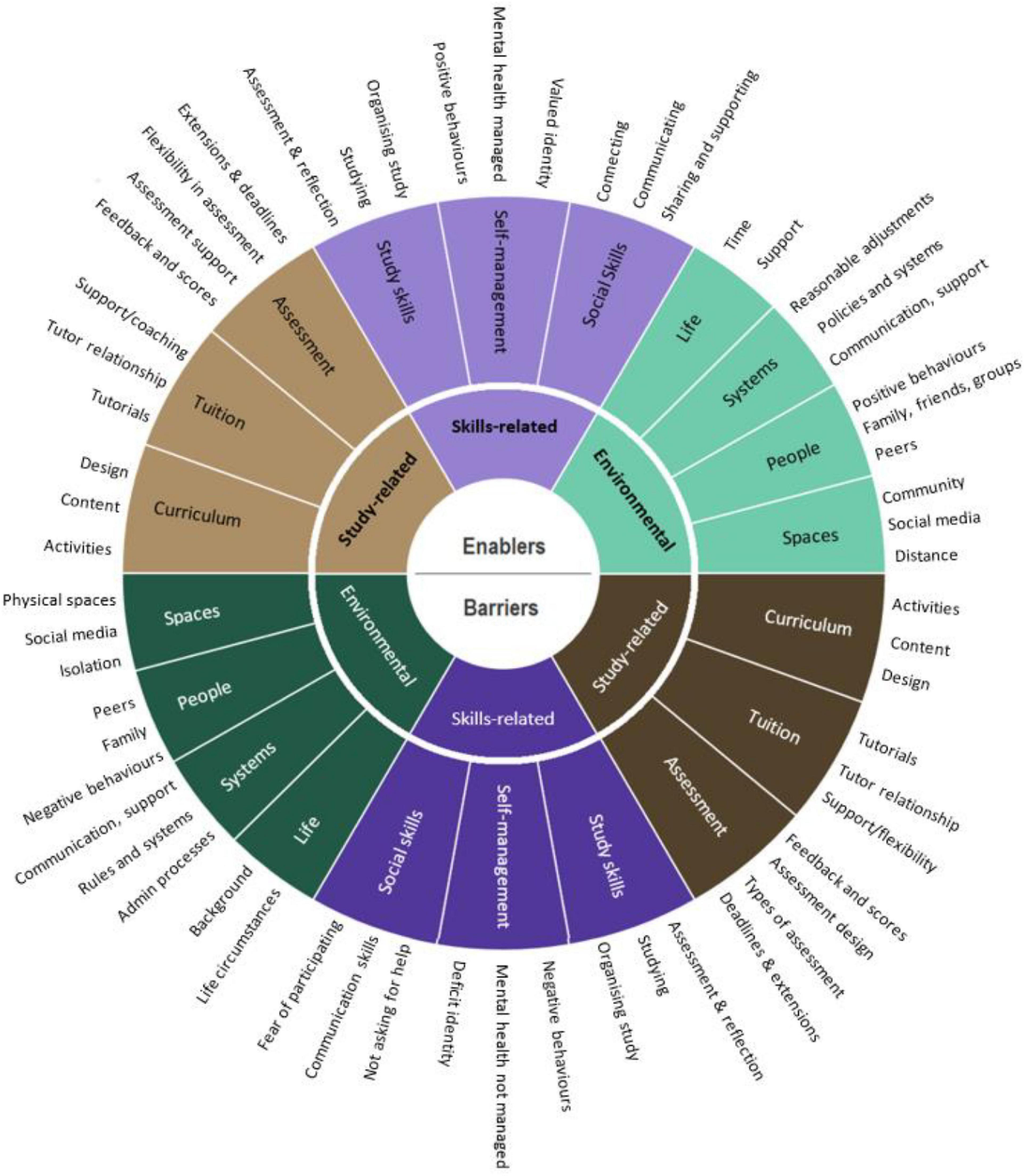
Figure 1. Taxonomy of barriers and enablers to mental wellbeing (Lister et al., 2021).
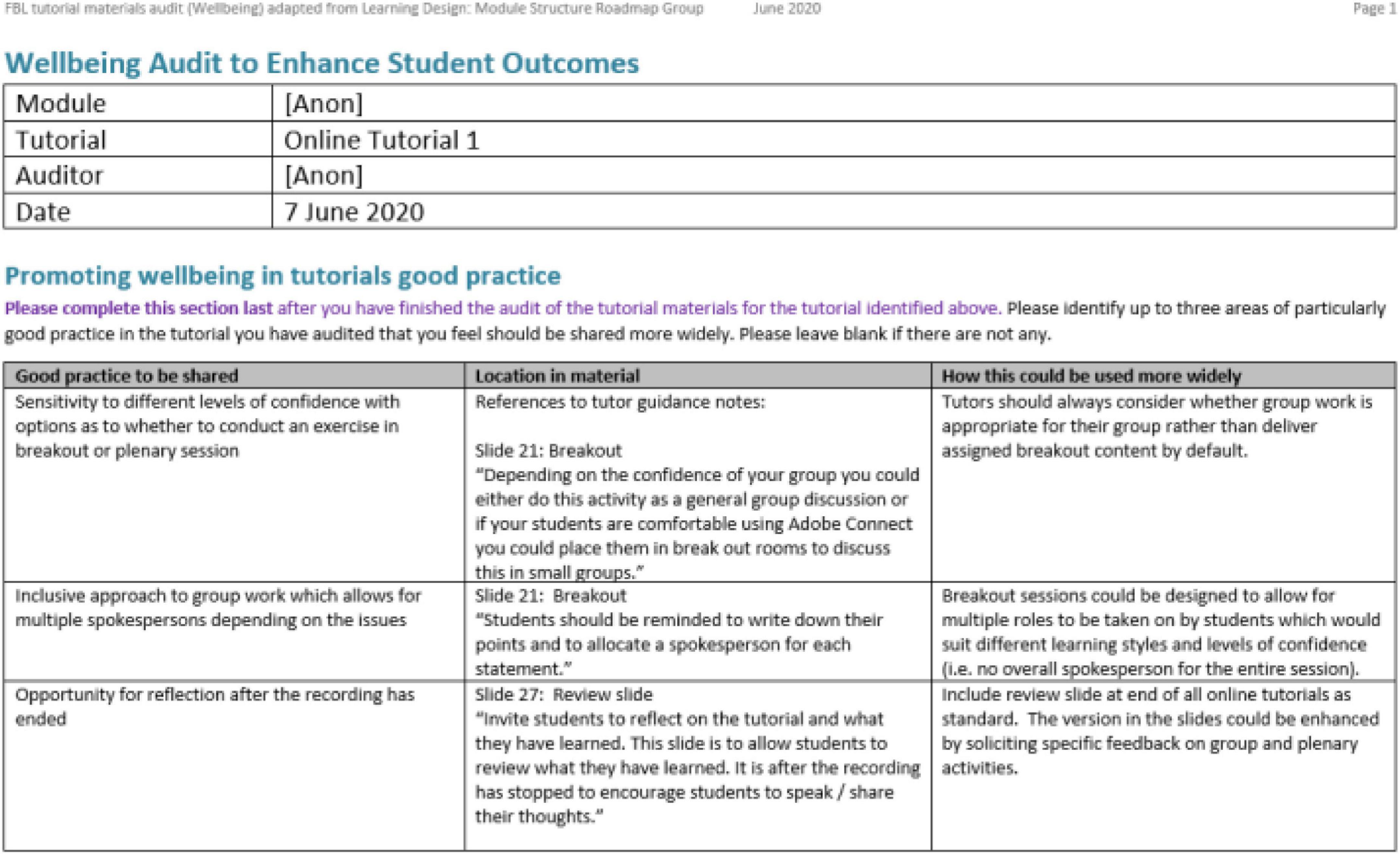
Figure 4. Open University example of the first page of a completed mental wellbeing inclusivity audit.
Assessment is frequently identified in the literature as a barrier to wellbeing; Jones et al. (2020) identify assessment design, collaborative work, challenges of assessment workload and post-assessment feedback as “psychological threats.” Baik et al. (2019) also found that assessment design impacted on wellbeing, with student perceptions of clarity and fairness in design being particularly critical, while Hill et al. (2021) highlight impacts of assessment feedback on student wellbeing. Finally, failure and fear of failure are major contributors to student academic stress or distress (Whittle et al., 2020).
Pedagogy and curriculum are also recognized to contain barriers to wellbeing. For example, Tinklin et al. (2005) identified “Lack of understanding among lecturers” and “badly designed learning experiences” as barriers (p. 510), and Baik et al. (2019) found that lack of clarity in teaching materials, low levels of classroom interaction and lack of variety in activities impacted negatively on wellbeing. Specific activities, such as groupwork, can be a barrier for wellbeing (McPherson et al., 2019), while impacts of power dynamics involved in faculty-centered as opposed to student-centered pedagogies have been found to affect students’ confidence and wellbeing (Felton and Stickley, 2004; Hill et al., 2019). Feeling “overwhelmed” by curriculum content has been linked to student withdrawal (Weller et al., 2018, p. 43), and distressing curriculum content has been shown to present particular mental health challenges for some students (Slavin et al., 2014; Bentley, 2017).
Barriers to wellbeing may also be linked with students’ skills and resilience. For example, Hewitt and Stubbs (2017) identify that difficulties with interpersonal skills, the skills involved in managing workload, and the discipline-specific study skills necessary to achieve good grades, may be a cause of depression, anxiety and stress for students. Similarly, Barrable et al. (2018) found that stress associated with “study skills difficulties,” particularly around “time management, staying motivated, and memory techniques” were a trigger for mental ill health and negative feelings.
Before exploring further literature, it is important to clarify our terminology, as definitions and language in mental health are controversial. It is generally accepted that “there is no universally acceptable lexicon” for discussing mental health, and that “language in this field is particularly contested, revisited and innovated” (Davies, 2014, p. 22). In this study, we adopt the WHO definition of mental health:
“a state of well-being in which every individual realizes his or her own potential, can cope with the normal stresses of life, can work productively and fruitfully, and is able to make a contribution to her or his community” (Galderisi et al., 2015).
We use the term “wellbeing” throughout this study to describe a broader dimension of mental health (Houghton and Anderson, 2017). We adopt terminology used in the HE sector, such as “condition” for something medically diagnosed; “difficulty” for something short-term or context-dependent, and “issue” for longer term and more pervasive impacts on mental health. With participants, we were careful to “mirror” the language and terminology they used so as to support their comfort (Lister, 2019).
Embedding wellbeing: Holistic and proactive approaches
In response to broader societal shifts in thinking around mental health and wellbeing (e.g., Davies, 2014), there have been a number of calls for universities to take a more proactive and holistic approach, working in partnership with students to embed mental wellbeing throughout learning, tuition and curricula (Houghton and Anderson, 2017; Hughes and Spanner, 2019; Piper and Emmanuel, 2019; Universities, 2020). However, there is a “lack of consensus” in HE around how best to do this (Hartrey et al., 2017, p. 26), which has led to a number of studies trialing individualistic, intervention-based approaches. These interventions generally show limited or short-term success (Winzer et al., 2018), and do not address underlying issues in university cultures and practices.
Holistic approaches to student wellbeing are not common in the literature, but work exists in this area. For example, since 2013, the chemistry graduate school in the University of Minnesota has been running a long-term “student empowerment” initiative, consisting of student surveys and focus groups to identify barriers to wellbeing, and working to reduce barriers based on the findings (Mousavi et al., 2018). Changes made in response to student feedback include:
• The introduction of skills-based advice sessions
• A revised feedback strategy
• An additional formative assessment milestone
• Revised administrative forms and processes
• Additional social events
• A coaching initiative
• A “women in chemistry” group
• A roadmap of roles and recommendations for students, graduate programmes and university mental health support services
The project has been participatory in nature, with students running initiatives and supporting the dissemination of findings and practice (Mousavi et al., 2018). The authors comment that students’ evaluations of the interventions have been positive, and the surveys have shown slight improvements in mental wellbeing, although many of these did not reach statistical significance. In spite of this, the authors comment that “the positive trend is encouraging and suggests that the mental health initiative activities are moving the Chem. Dept. [Chemistry Department] in the right direction” and that they are continuing the programme and the surveys (Mousavi et al., 2018; Anderson et al., 2019). The initiative has since been adopted by other departments in the university as part of a holistic, university-wide strategy for student mental health (Buhlmann, 2020; Faircloth, 2021).
Another example of a holistic, social-model approach in the United States is the Engelhard project, a curriculum infusion approach where content about mental health is embedded (“infused”) across curriculum and assessment, coupled with inclusive design principles that support wellbeing. Georgetown University has adopted this approach holistically across its programmes, with content, discussions, presentations and activities explicitly teaching mental health literacy and embedding emotional awareness and reflection on wellbeing (Olson and Riley, 2009; Valtin et al., 2018; Georgetown University, 2022). The approach involves partnership between lecturers and mental health professionals, although no mention is made of partnership with students in the project. At the time of writing, the Engelhard project website states that the approach has been running since 2005; it has been applied in over 500 courses, and lists 18 case studies of curriculum infusion in different disciplines (Georgetown University, 2022). Project publications give examples of positive student testimonials and state that the project has had a positive impact on wellbeing for students and staff, but it is not clear whether these have come from a formal evaluation (Olson and Riley, 2009; Valtin et al., 2018).
There is clear potential for holistic approaches to student wellbeing in the United Kingdom. In 2020, Riva (2020) investigated how teaching practices and learning settings contribute to experiences of wellbeing in universities, identifying four key themes to concentrate upon for improving students’ wellbeing in the study setting: creation of a student-centered environment, mitigation of a lack of intercultural and international integration, increased emotional intelligence, and recognition of an intertwined connection between staff and student wellbeing. Similarly, Lister et al. (2021) investigated student mental wellbeing in the distance learning environment, adopting a social model approach (Oliver, 1983) to identify barriers to student mental wellbeing in practices and environments rather than deficits in individuals. Lister et al. (2021) found that a range of barriers and enablers to mental wellbeing reside throughout distance learning environments, practices, and development of students’ skills; these are represented as a taxonomy and are shown in Figure 1.
Partnerships and participatory approaches
Participatory approaches to mental health, wellbeing, and inclusion can be found in literature from a range of relevant disciplines. In healthcare research, case studies of participatory mental health research are vast and varied; they include (for example) working with service users in Ethiopia to develop a model of mental health service user involvement (Abayneh et al., 2020); a research project in Canada to investigate medical interactions and housing issues for people diagnosed with schizophrenia, in which the participants participated in “every aspect” of the research and dissemination (Schneider, 2012, p. 153); and a community-based participatory study in the United States to identify mental health service needs, perceptions of mental health services and the barriers to accessing support, for the Latino population in North Carolina (Shattell et al., 2008). In disability studies, the social model of disability (Oliver, 1983) places high value on participation, contending that disabled people should be involved in the process of any research, policy or legislative decision that affects them. Callus and Camilleri Zahra posit that “It is disabled people themselves, with support where necessary, who should determine what their own needs are” (Callus and Camilleri Zahra, 2017, p. 11), and this is commonly encapsulated in the slogan “nothing about us without us” (Charlton, 1998).
In educational research, there is recognized synergy between critical inquiry and participatory approaches; Cohen et al. call participatory research “an instance of critical theory in research” (Cohen et al., 2013). Seale emphasizes the need for educational research and practice to be proactive in seeking participant or student voice, and for this voice to be authentic and not mediated by the researcher (Seale, 2014). Participation can take many forms, including representative groups (Callus and Camilleri Zahra, 2017), narratives of lived experience (Franits, 2005), focus groups and case studies (Long et al., 2017). Seale also highlights that researchers need to seek out and identify silences as well as voices; to “examine whose voices are heard and ignored and where the silences are in relation to unanswered questions, unaddressed tensions and lack of criticality” (Seale, 2014, p. ix). This position recognizes the reality of a “culture of silence”, in which silence is imposed on marginalized groups (such as people with mental health issues) as a form of oppression (Freire, 1972), and draws on “sociology of absences” research (Santos, 2001) to challenge marginalization or suppression of voices, and enable struggles and knowledges to be voiced (Santos, 2001). In higher education research, seeking silences often means ensuring that staff participants from different areas are included, as well as students and other stakeholders (Seale, 2014; Lister et al., 2021).
Participatory research can be deeply creative, with a wide variety of different methods for managing effective participation (Flewitt et al., 2018; Rix et al., 2020; Lister et al., 2021). However, with any kind of participatory research, it is important to ensure that the partner participants are contributing within their comfort zone, feel part of the project, and are not uncomfortable, over-stretched or exploited. This raises a number of tensions and ethical considerations. Degrees of participation vary highly, with some projects only offering tokenistic participation such as consultation, where partners have no real power or agency in the project (Arnstein, 1969). Also, it is commonly felt that in order for research to be truly participatory, partners should be involved throughout the entire research, including data analysis and dissemination (Jackson, 2008; Rix et al., 2020). Yet very few studies exist where this is the case, with lack of time, lack of funding, or a skills gap in partners commonly cited as reasons. Consequently, truly participatory research ideals have been critiqued as being too impractical for common adoption. However, it is generally recognized that any participation is better than none, and it is important to balance the needs of the partner participants and restrictions imposed by funding and timescales against the wider ideology of participation.
A tale of two studies
Building on Riva’s (2020), Lister et al.’s (2021), and Lister and McFarlane’s (2021) research, this paper presents and comparatively evaluates two participatory studies from different United Kingdom higher education institutions, aiming to support student mental wellbeing in higher education using online and technology-based approaches. Both aimed to provide holistic, proactive and inclusive digital solutions that addressed barriers to wellbeing students had experienced. The first is the creation of the digital “Wellbeing Pedagogies Library” at the University of Warwick; the second is the “Mental Wellbeing in Distance Learning” project at the Open University. A brief overview of each project is given next.
The “Wellbeing Pedagogies Library” is a digital repository built to foster the sharing of pedagogical practices that support student wellbeing, and to offer practical support to students and staff who want to create and/or sustain wellbeing inducing teaching and learning environments. The repository records, collates and disseminates staff and students’ practical, successful pedagogies and helpful activities that bring conditions for improving wellbeing in study settings. It was co-constructed with students and staff stakeholders, and is structured to provide a clear classification of pedagogies, based on Riva et al.’s research (Riva, 2020).
The “Mental Wellbeing in Distance Learning” project at the Open University was a facilitated practitioner research project, consisting of five practitioner-led subprojects aiming to address barriers to wellbeing in several aspects of distance learning. The subprojects comprised:
• Staff training: a digital micro-credential on embedding wellbeing in the curriculum
• Learning Design: a model for embedding wellbeing in online module production
• Tutorial materials: a digital self-assessment tool for tutors for auditing wellbeing in tutorial materials
• Distressing or triggering curriculum content: a staff website with guidance and support for teaching and studying potentially distressing topics
• Student wellbeing resources: “Your wellbeing” webpages, containing discipline-specific and programme-specific wellbeing guidance
These two projects took place in different higher education contexts, independently of each other, but they share common purposes in aiming to embed mental wellbeing in higher education, following a holistic approach, and in creating collaborative partnerships with students and staff stakeholders to achieve this. They therefore present an opportunity for comparative evaluation, in which the value and benefits of the participatory methods can be explored.
Materials and methods
This paper uses a comparative evaluation (Vartiainen, 2002) methodology in order to explore, compare and critically evaluate the two projects. We present the participatory methods and approaches from each project, we explore stakeholders’ perceptions of the value that participatory approaches added to the projects, and we comparatively evaluate the projects’ outcomes in order to draw conclusions that can inform future participatory research. In doing this we aim to answer the following research questions:
1. How can staff and students work in partnership to embed mental wellbeing in different higher education contexts?
2. What value/benefit is added by participatory approaches when it comes to embedding wellbeing in higher education?
3. What can be learned by comparatively evaluating the projects?
The methodologies of the respective projects are described in the next two sections.
Wellbeing Pedagogies Library digital repository
This project took place in the University of Warwick, a public research university in the United Kingdom and a member of the Russell Group of research-intensive United Kingdom universities (Furey et al., 2014). In the 2021–22 academic year, Warwick had 29,534 students, of whom 861 (2.9%) disclosed a mental health condition or difficulty.
The objective of the project, building on work by Riva (2020), was to build a digital repository of wellbeing positive pedagogies which was usable by the entire learning community. It was built according to critical pedagogy principles of agency and empowerment of learners (Freire, 1970), aiming to ground digital learning experiences in the practices of collaboration, community building, human connectivity and equitable distribution of power over the learning process.
The first part of the project methodology was co-creation (Bovill, 2020; Riva et al., 2022), defined as “occupying the space between student engagement and partnership, to suggest a meaningful collaboration between students and staff, with students becoming more active participants in the learning process, constructing understanding and resources with academic staff” (Bovill, 2020, p.1024).
First, the co-creation team was established, with three student officers recruited to co-lead on the project with two members of staff. Next, the student co-creators “collected” wellbeing pedagogies using recorded semi-structured interviews with staff and facilitated dialogues between students utilizing the “Friendship method” (Heron, 2020). The friendship method involves “friendship pairs” undertaking recorded conversations, guided by prompts without a researcher present. This aspect of the initial data collection was led by students, with support from the rest of the team.
Further input from a wider group of stakeholders was then sought via surveys and focus groups. Over 100 staff and students were consulted, and although specific findings from this activity are not presented in this paper, it is important to note that thoughts and opinions from this group informed the selection of the pedagogies and the structure of the repository.
The project was evaluated using a mixed-methods approach. Drawing on Ortlipp’s research and framework (Ortlipp, 2008), staff and student co-creators kept reflective accounts and journals throughout the project. As part of this, staff and students shared reflections on their experience of participating in the project, and this was included in the evaluation. Additionally, library users were asked to provide feedback via an anonymous online feedback form about the repository content, accessibility, structure, and its usefulness in supporting the embedding of wellbeing in the curriculum.
Qualitative analysis of closed questions was executed by the co-creators using SPSS, while thematic analysis of open questions was conducted following a recognized six-phased thematic method (Braun and Clarke, 2006; Nowell et al., 2017). Thematic analysis was carried out using a deductive approach to identify initial coding categories, recognizing the impact of the theoretical drivers.
Warwick participants
The project co-creators consisted of a team of three students (two female undergraduate students and one male postgraduate student) and two academic staff.
The student co-creators interviewed 24 members of staff (14 female, 10 male) and 20 students (11 female, 9 male). All the members of staff were academics who teach across all the three Warwick Faculties (6 Science, Engineering and Medicine, 10 Social Sciences, 8 Arts) with representatives from a wide range of disciplines and departments. The students voluntarily self-selected for interview, based on prior involvement in partnership or precursor work. Following this, a further 77 staff and 30 students were consulted via survey and focus groups on the final selection of pedagogies and the library design (Table 1).
As part of the library evaluation, 349 users shared feedback via an anonymous feedback form. Responses were received from 254 staff and 95 students, but no other demographic details were captured.
Mental wellbeing in distance learning
This project took place in the Open University (OU), a large distance learning university in the United Kingdom. In the 2021–2022 academic year, the OU had 164,801 students, of whom 23,660 (14.4%) disclosed a mental health condition or difficulty.
This project built on work by Lister et al. (2021), aiming to identify barriers and enablers to mental wellbeing in distance learning. The method for the overarching project was facilitated practitioner research (Groundwater-Smith et al., 2012; Yuan and Lee, 2015), where practitioners are supported to design and lead subprojects of their choosing, within the overarching project. Each subproject chose to follow its own participatory methodology; these are described in the Results section in this paper.
First, in order to identify subprojects and practitioners to lead them, focus groups were held with 107 staff and 9 students. In these, staff and students collaborated to identify and design subprojects that could address barriers and begin to embed mental wellbeing in distance learning. Vignettes of student experiences (Darvin, 2011) were used to support participants to identify priority areas, and workshop-style activities were run following a “problem posing” approach to encourage participants’ critical consciousness and identify collaborative, community-driven, solutions to barriers (Freire, 1970; Kincheloe, 2004). Sixteen subproject ideas were identified, seven subprojects went ahead, and five subprojects were completed successfully. The full methodology and findings of these focus groups are described in two other publications (Lister and McFarlane, 2021; Lister, in press).
The five subprojects were coordinated using a facilitated practitioner research approach (Groundwater-Smith et al., 2012; Yuan and Lee, 2015). Following Yuan and Lee’s (2015), the subprojects were centrally coordinated, “scaffolded,” and aligned. Practitioners led their own teams, decided their own methods, set the pace of their subprojects and determined the level of involvement or support they wanted from the project overall lead. All subprojects involved participatory approaches, with students and staff in different roles in the subproject teams. Individual subprojects are described in the Results section of this paper.
The evaluation of these subprojects followed a mixed methods approach. First, reflective interviews were held with subproject leads using a practitioner-led reflective evaluation approach. Interviews were semi-structured, drawing on Hardy et al.’s (2011) “PRAXIS evaluation framework” and Baumfield et al.’s (2013) suggested reflective questions for practitioner inquiry to facilitate shared reflection (Scharmer, 2001). Interviews took place using Microsoft Teams and each lasted 30–45 min.
Second, surveys were sent to students and staff, asking (among other things) their opinions of the subprojects and whether they thought they would be beneficial for student mental wellbeing. Both the student and staff survey instruments were co-designed with a team of students and feedback was sought from a wider group of staff and students in a survey pilot. The survey analysis was also participatory, with a small team of students working with the subproject lead on both quantitative analysis of closed questions, using SPSS, and thematic analysis (Braun and Clarke, 2019) of open comments, using NVivo.
Open University participants
The participants in the overarching project (and five subprojects) were students, and academic and academic-related staff from across the university. Participants voluntarily self-selected, based on prior involvement in the focus groups that preceded the projects. The distribution of roles is shown in Table 2.
The evaluation of the project involved a larger group of participants, and took the form of staff and student surveys.
The student survey was sent to two stratified random samples of students; 2,500 students who had disclosed a mental health condition to the university; and 2,500 students who had not disclosed a mental health condition. The samples were stratified by the OU Surveys team to be representative of the broader cohort in terms of gender, ethnicity, faculty and geographic location, with under 1.4% variance. In total, 584 students responded to the survey (11.68% overall response rate.) The response rate was higher for students disclosing a mental health difficulty, with 340 responses (13.6%) compared to 244 responses (9.76%) from students who did not disclose a mental health condition. Student demographics are shown in Table 3.
The staff survey was sent to 2,170 staff as part of a regular (biennial) accessibility and inclusion survey (Lister et al., 2020). Distribution of staff groups, response numbers and response rates are shown in Table 4.
Results
This section presents findings from the Warwick and OU projects.
Wellbeing Pedagogies Library digital repository
The Wellbeing Pedagogies Library aimed to foster the sharing of wellbeing practices and offer practical support to staff (and students) who want to create and/or sustain wellbeing inducing learning environments. The co-creation process aimed to facilitate student-staff relationships, allowing them to connect, collaborate and work together. It also aimed to enhance students’ agency, their active participation, and their negotiation and decision-making abilities (Dollinger et al., 2018). This section presents findings, particularly:
• The wellbeing pedagogies that students identified
• Staff and student evaluation of the completed digital repository
• Staff and student experiences of the participatory approach
Wellbeing pedagogies
Student officers initially “collected” 113 wellbeing pedagogies via conversations with staff and facilitating dialogues among students utilizing the “Friendship method” (Heron, 2020). These were later refined to 83 with the help of staff/student consultants, because of lack of concrete, replicable examples to support the pedagogies and to avoid repetition.
Wellbeing pedagogies were defined as learning and teaching practices that are designed and delivered acknowledging the impact that the learning environment has on student and staff wellbeing, and that strive to positively support staff/students wellbeing in terms of feeling and/or functioning. Some examples of the pedagogies are shown in Table 5, organized into categories identified in previous research as crucial aspects of a positive learning environment.
Evaluation of the wellbeing library
The final output of the project was an open access e-repository hosted on the University website. It is available at https://warwick.ac.uk/wellbeingpedagogieslibrary; an image of the landing page is shown in Figure 2.
Since its launch in November 2020, the repository has been accessed by over 7800 different users from Warwick and beyond. Library users were invited to anonymously complete a feedback form about their experience of utilizing it; at the time of writing, 349 users had shared feedback (Staff N = 254; Students N = 95). Results are reported in Table 6.
Both staff and students found the e-repository useful to support the embedding of wellbeing in the curriculum. Both groups liked the design, content, and found it easy to navigate. There were small differences between student and staff responses, but these were not statistically significant.
It was interesting that the lowest positive response, from both staff and students, related to perceptions of how relevant the library was for other departments. This may reflect a lack of willingness to comment on what other departments may find relevant.
Staff and students were also asked open questions on what they liked and did not like about the repository and to comment on their experience of using the library. From the thematic analysis of the responses, three overarching themes were identified:
• Ease of use
• Variety of collated practices
• Support of “emotional” and “physical” labor associated with embedding wellbeing in curricula
Firstly, the library was seen as accessible and easy to use, to present information in a variety of media and in a clear and cohesive manner.
“It made very clear the scope of the Library and what a Wellbeing Pedagogy is.” Staff User
“It is easy to navigate and provides content in a very cohesive manner. Pedagogies are well explained, and you have enough information for really capturing what happens in the classroom/online environment in practice and to re-apply it.
I like the filtering system – I was able to search for pedagogies tailored to my teaching needs (small class, postgraduate students, online, assessment, etc.).” Staff User
However, the filtering system was felt to be a less user-friendly aspect of the repository (“Filtering system could be improved, but works!” Student User)
Secondly, the variety of pedagogies was perceived to be a benefit, and students commented that library contained useful resources for them to use when studying.
“I am blown away from the variety of practices presented. From online to f2f, from reading lists to assessment, from study tips to how to relax while revising, there is something for everyone, including people that have to teach and learn in very large classes.” Student User
“Love this – I have a place to go when I need to find tips for my wellbeing when studying. Very generous of staff and students to share all this!” Student User
Finally, the repository was seen to support the labor associated with the task of embedding wellbeing in the curriculum, both on a physical level (e.g., “I always felt this was going to be a mammoth task but now I have a pedagogy ready to apply. It might sound odd, but I feel relieved! So many thanks!” Staff User) and on an emotional level (e.g., “I have always been “scared” of utilising certain grouping strategies and I feel now far more secure. Thank you!” Staff User). They also reported feeling inspired and empowered, e.g., “I feel empowered when going back to my department and arguing for thinking more about Wellbeing in our courses.” Staff User.
Overall, users appreciated the library design, having a large pool of pedagogies to choose from, and felt the library empowered them to re-apply practices within their own context.
Experiences of the participatory approach
Staff and student co-creators reflected via journal entries on the experience of working on the co-created project; all reported on the value of this participatory approach.
Staff commented on enjoying the process and trusting the students:
“Co-creation has been an incredible experience. Trusting the student officers” vision, negotiating decisions with them and the other member of staff, sharing leadership has yielded a much better final repository and while challenging at times, it has also made the process truly equitable and enjoyable.” Staff co-creator
Students commented on feeling valued and respected:
“I felt extremely valued when I was part of this team, thanks to the culture of co-creation and of enabling meaningful dialogue that we regularly engaged in. Even though I was a student, I felt like my contributions and ideas were treated with equal value and respect, this was important to me and gave me confidence to put my ideas forward.” Student co-creator
Students also talked about the benefit to them in terms of gaining skills:
“I wish that the opportunity for staff and students to collaborate on projects becomes more widespread at Warwick. As a student, I gained so many valuable skills on this project. It is important to recognise that we are all learners in this community, both staff and students have a lot to gain by breaking away from traditional hierarchies, working together and engaging in meaningful co-creation.” Student co-creator
Further reflections were gathered from staff who had a more tangential role in the project, as staff who were interviewed for the gathering of wellbeing pedagogies often shared unprompted reflections about the experience of being part of the project. They consistently reflected on the opportunity of having a conversation with student co-creators about their practices and how this has allowed to evaluate them to a greater extent:
“Participating in this interview gave me the opportunity to discuss my pedagogic approach with you [student] in a way I had never done. I can see with more clarity what works wellbeing in what I do in the classroom!” Staff – Wellbeing Pedagogy leader
“You really allowed me to look at what I do from another angle. I have not had such a good conversation about my teaching approach in years! Thank you for ‘grilling’ me and pushing me to provide practical examples.” Staff – Wellbeing Pedagogy leader
In addition, they reflected on the unique opportunity to share their teaching expertise, gaining recognition for practices they developed:
“I never had the possibility to share my wellbeing teaching interventions and to be recognised for it.” Staff – Wellbeing Pedagogy leader
“For once I felt that my work as a teacher was valued and that I was not ‘robbed’ of my ideas but celebrated for it. And I love the fact that colleagues can make the most of what I have created without having to reinvent the wheel!” Staff – Wellbeing Pedagogy leader
Staff and student consultants who contributed to the decision-making process for the final selection of pedagogies and layout via focus groups and online survey also reported positive feelings of participation:
“I liked the idea that I was consulted at the beginning of the project via online survey and a focus group… It was such a change as I always get consulted on the final outcome when it cannot count in the same way.” Consulted Student
“It was nice helping the co-creators to come up with the right template for the pedagogic entries. As a perspective user of the library, I got the chance to say which information I would have liked to see per each teaching suggestion. It really felt as a community effort.” Consulted Staff
Mental wellbeing in distance learning
The Mental Wellbeing in Distance Learning project resulted in five completed subprojects. This section presents findings from each, including the participatory methods each subproject followed (as part of the facilitated practitioner research methodology), reflections from the interviews on the value that participatory approaches added to the subproject, and the final output of each subproject. Finally, it presents survey data from wider groups of staff and students on their perceptions of whether the subprojects would support student wellbeing in distance learning.
Staff training: A digital micro-credential on embedding wellbeing in the curriculum
This subproject aimed to create an online professional training course for OU staff and other educators on embedding mental wellbeing in curricula and practice. It was decided that the course would be a 15-credit postgraduate micro-credential, hosted on the FutureLearn platform, named “Teacher Development: Embedding mental health in the curriculum.”
This subproject’s methodology was a participatory version of the OU’s learning design approach. It aligned to critical pedagogy as a theoretical framework, and the team worked in partnership with students and other practitioners throughout the course design and production. Student voice was embedded throughout the course through a series of student videos, students contributed to the overall content, both as direct authors and in an indirect way, and the course featured a final motivation video accompanying the final assessment, which came from a student. This created an interesting, yet very positive, dynamic, as this was a professional development course for teachers and educators, where much of the learning was delivered by students.
The subproject team followed a reflective dialogic pedagogical approach (Freire, 1974; Gadotti et al., 1996), with video discussions between the educators reflecting on their experiences forming part of the course materials, and discussion between learners forming a core part of the module. The team also secured endorsement from the Mental Health Foundation, who participated in the course design as critical readers.
In the reflective interview, the subproject lead reflected on the value of working in partnership with students, saying:
“student voice was clear throughout the course design and production. It meant we could make the student videos that we included throughout the course. They really added to the final experience.”
She also reflected on the experience of working on the subproject, saying
“It has changed the way in which I think about things. It prompted me to reflect on a lot of my own teaching, past and present. A level of self-awareness, combined with a reflection on my own experiences as a learner. It’s been, maybe not cathartic, but it has helped me to make sense of some of my own experiences.”
The output of this subproject was a micro-credential for educators on embedding mental wellbeing in the curriculum (see Figure 3). It ran for the first time in March 2020, and has run six times since then. At the time of writing, it had been taken by 469 practitioners in different educational contexts and had received very positive feedback. Comments from practitioners included:
“Thank you for the course which will prove to be very helpful in the planning of a new curriculum around health and wellbeing”
“A REAL EYE OPENER!!!!!!!!!!!!!!!!!!!!!!!!!!!!!! I’ve learned so much. I discovered so many new ideas and concepts. Thank you so much.”
Learning Design: A model for embedding wellbeing in online module production
The Mental Wellbeing in Learning Design subproject aimed to embed design considerations in relation to student wellbeing in the existing learning design infrastructure in place at the OU (Rienties and Toetenel, 2016; Weller et al., 2018). The team aimed to synthesize the barriers and enablers created by Lister et al. (2021), combined with solution ideas generated in focus groups, in order to create a succinct set of tangible recommendations that could be made to module teams in production, which could then be operationalized through the module design process.
This subproject’s participatory methodology was both partnership and consultative; a small number of students were partner members of the subproject team, and they consulted a wider group of students in a Learning Design student panel. First, the team reviewed and synthesized the recommendations from the focus groups, aligned them with the barriers and enablers identified by Lister et al. (2021), clustered them and formatted them into recommendations that could be made in module design. This resulted in a set of 49 recommendations; the team then presented these to the panel of students, asking them to refine the list by selecting the recommendations they felt would have the most impact on their wellbeing. The panel’s individual rankings were collated and the top 12 were incorporated into the standard learning design recommendations.
In the reflective interview, the subproject lead reflected on the value of the participatory approach, saying “What’s been nice is seeing how things are coming together. It’s encouraging. Seeing the overlaps, being able to put the word wellbeing into different things.” She also reflected on her personal growth through working with the subproject team, saying:
“I think wellbeing is something I hadn’t thought of before. It feels as if it’s risen to the surface to lots of different contexts. Normally, a lot of the focus is on retention, outcomes, hard targets. But so much of that is affected by students’ wellbeing. The emotional aspect of study is often overlooked, but that has a real effect on how well they do.”
The outcome of this subproject was the addition of the finalized recommendations to the OU’s Learning Design approach, including a section in the Learning Design workshop slide deck and accompanying guidance.
Tutorials: A digital self-assessment tool for tutors for auditing wellbeing in tutorial materials
This subproject aimed to create an audit tool that tutors could use to identify how well represented mental wellbeing was in their tuition materials, and to trial this tool in one faculty.
This subproject used participatory design as its approach, involving participatory design workshops with tutors and students to design and refine the audit tool. The final tool was then piloted with a small number of tutors before being rolled out more widely.
The subproject lead reflected on the value and impact of the participatory approach, saying:
“It’s multi layered, like an onion. I’m at the centre of the onion, I have developed my own practice, changed my language and approach. From there, that has led onto the ALs [associate lecturers, or tutors] who are undertaking the audit, and you can see that reflected in their feedback. Then that’s also spread out to the SEMs [student experience managers] in mental health awareness and critical consciousness. Not just in the people who’re already reflective but also the older school thinkers. I think this has. Two SEMs who people are not positive about mental health emailed me after the session to say how valuable it was. I did struggle to get buy in 3 years ago, but we have improved critical consciousness enormously.”
The outputs of this subproject were an inclusivity audit tool for tutors, combined with widespread training for tutors in the Faculty of Business and Law on student wellbeing, and a set of completed audits that could be used to evaluate, reflect on or share practice (see Figure 4).
Distressing or triggering curriculum content: A staff website with guidance and support for teaching and studying potentially distressing topics
This subproject aimed to create guidance for practitioners on teaching potentially distressing content. This included a whole-university approach to trigger warnings or content notes, exemplar text to be adapted by module teams, and guidance for tutors and students.
The participatory methodology was iterative consultative design. The subproject lead consulted with students and staff stakeholders across the university, both by email and by holding 15-min consultative input sessions in all the university’s and student association’s major strategic groups’ meetings. These sessions informed the guidance and approach, refined them through various drafts, and each group signed off approval of the guidance and approach in their final forms.
The subproject lead reflected on the value of the consultative approach followed, saying:
“We never would have got so much buy in from people if we hadn’t worked with them throughout. It meant the content was much more rigorous and was informed by students’ lived experiences, which resonated with people. And it meant that when the final version was ready, all our stakeholders were already on board.”
The output of this subproject was a staff website, with a consistent, university-wide approach for teaching distressing content, and template wording and guidance that could be adapted for tutors and students. An image of the site is shown in Figure 5.
Student wellbeing resources: “Your wellbeing” webpages, containing discipline-specific and programme-specific wellbeing guidance
This subproject aimed to create hubs of wellbeing resources for students that were curated for the specific programme and discipline they were studying. These would be hosted on students’ “Study Home” websites, which were managed by programme teams and shared by all students on a programme. The “Your Wellbeing” sites aimed to provide:
• Links to mental health and study support for students who need it (e.g., Student Support contacts and links)
• Opportunities for students to explore how to manage their wellbeing (e.g., links to open access therapy or meditation apps, as well as guidance on nutrition and study habits)
• Discipline-specific guidance (e.g., on maths anxiety, performance anxiety for foreign language courses and other guidance specific to disciplines)
• Guidance on study skills relevant to the qualification (e.g., exam skills and anxiety guidance for courses with exams, guidance on giving presentations for courses that had this in the assessment strategy, etc.)
The methodology was co-construction; each element of the website design was co-constructed by a team in a series of working meetings. Members of this team included students, representatives from the Learner Experience and Technology team, the OU Students Association, the Student Support teams, mental health experts, website owners and faculty representatives.
The subproject lead commented on the value of the participatory approach, saying:
“Everyone has been very involved, all on the same page, with the same aims and objectives… It’s reinforced my belief that there are so many people in the OU who want to do the best by our students, and I’m really pleased how we’ve brought some of them together in this.”
She also talked about the practical benefit of the participatory focus group that led to the subproject, recounting a moment in the planning in which they needed to check logistics. Instead of an arduous process of finding out who the responsible people were, sending emails and awaiting responses, they were able to call across to the next table where the relevant people were sitting, and talk about what they needed.
The outputs of this subproject were webpages with course-specific and discipline-specific guidance on skills building and mental wellbeing (see Figure 6). These went live to students on 34 “Study Home” websites in March 2021.
Survey evaluations
Staff (N = 666) and students (N = 584) were asked whether they believed the five subprojects would be beneficial. As Figure 7 shows, more than half of the student respondents believe all the subprojects will support their wellbeing, with the staff training micro-credential receiving the most positive responses (68%, N = 398). The staff training was also the most popular subproject with staff respondents, with 78% (N = 519) saying they thought it would help wellbeing.
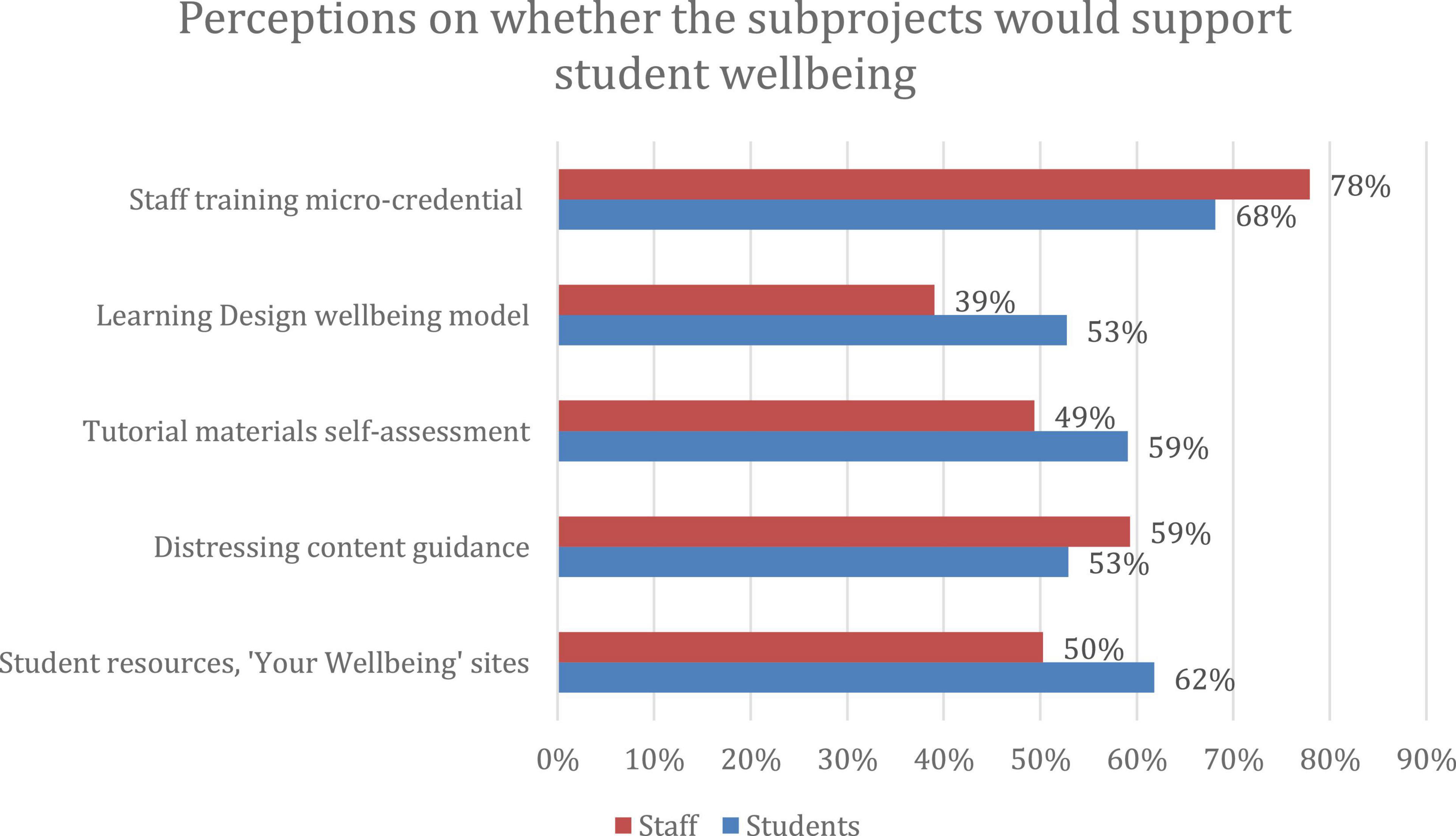
Figure 7. Open University staff and student survey responses on whether subprojects would help wellbeing.
Opinion was more divided over the other subprojects. Students’ second choice was the “Your Wellbeing” websites (62%, N = 361), while the staff second choice was the distressing content guidance (59%, N = 395).
There were no statistically significant differences between the responses of students with different demographics. However, the different staff groups varied in responses over perceptions of effectuality of all the subprojects except the staff training. The different responses are shown in Figure 8.
Discussion
The two projects (and five subprojects) discussed in this paper are different in nature; they took place in different higher education contexts independently of each other, they featured different groups of participants, different aims and a variety of different participatory approaches. However, they shared a common purpose in that they aimed to enhance student mental wellbeing in higher education learning and teaching.
This section of the paper comparatively evaluates the projects according to three research questions:
1. How can staff and students work in partnership to embed mental wellbeing in different higher education contexts?
2. What value/benefit is added by participatory approaches when it comes to embedding wellbeing in higher education?
3. What can be learned by comparatively evaluating the project outcomes?
RQ1: How can staff and students work in partnership to embed mental wellbeing in different higher education contexts?
Within the two projects, a wide range of participatory methods can be found. These vary in how participatory they are, ranging from consultative approaches through to student-led partnership (Arnstein, 1969).
In the OU project, the facilitated practitioner research approach inspired a variety of different participatory methods on subprojects. These included collaborative learning design with students, consultation with a student panel, having students as members on the core subproject team, participatory design workshops, iterative consultative design, and co-construction. None of the OU subprojects were led by students, but they had meaningful input in all, with many subprojects adopting more than one participatory method. Warwick’s co-creation approach contrasted with this, as they had students lead on an element of the project, and included them as project members in the wider project. Their use of the “friendship method” (Heron, 2020) is novel, and clearly brought value to the project.
Methods such as participatory design workshops and partner consultation are common in the literature on participatory research or participatory design approaches, but the Warwick findings imply these are enhanced when another participatory method is also followed, such as having students on the project team (Bergold and Thomas, 2012; Lister et al., 2021) or when students take ownership of an element of the project.
RQ2: What value/benefit is added by participatory approaches when it comes to embedding wellbeing in higher education?
The open comments in the interviews with project participants at the OU and Warwick raised a number of themes around the value/benefit of the participatory approaches used.
First, there was a theme around enjoying the participatory process, and feeling valued and recognized within the team. Students at Warwick talked about feeling valued as a contributor, e.g., “I felt extremely valued when I was part of this team”, while staff talked about feeling their work was valued (i.e., “for once I felt that my work as a teacher was valued and that I was not ‘robbed’ of my ideas but celebrated for it”) and recognized (“I never had the possibility to share my wellbeing teaching interventions and to be recognised for it.”) Staff at Warwick also commented on how this made the process enjoyable “it has also made the process truly equitable and enjoyable.” This supports other literature finding links between participatory approaches and participants feeling “valued, heard and appreciated” (Lucero et al., 2018).
Secondly, staff participants felt the participatory approach meant that the final output was better quality; e.g., “yielded a much better final repository” (Warwick staff), “really added to the final experience” (OU staff), and “It meant the content was much more rigorous and was informed by students’ lived experiences, which resonated with people” (OU staff). This is a common theme in literature relating to participatory design (Hansen et al., 2019; Lister et al., 2021).
Finally, there was a theme around the transformative impact of the projects, due to their participatory nature. There is a strong link in the literature between participatory research and the transformative paradigm in educational research (Mertens, 2007; Cohen et al., 2013). One OU staff member said “It’s been, maybe not cathartic, but it has helped me to make sense of some of my own experiences,” while another commented on the wider transformative impact, saying it was “multi layered, like an onion.”
Students also found the experience transformative, talking about the benefit to them in terms of gaining skills (i.e., “As a student, I gained so many valuable skills on this project” – Warwick student) and confidence (i.e., “gave me confidence to put my ideas forward” – Warwick student). This supported the project aim to enhance students’ agency, their active participation, and their negotiation and decision-making abilities (Dollinger et al., 2018).
RQ3: What can be learned by comparatively evaluating the projects?
Vartiainen (2002) highlights that using a comparative methodology between phenomena (in this case, projects) may take the form of comparing phenomena directly with each other, or with comparing them both to points within a selected framework. In this case, both projects aimed to provide holistic, proactive and inclusive digital solutions that addressed barriers to wellbeing students had experienced; these aims therefore provide suitable points of comparison.
The two projects interpreted “holistic” in different ways. In Warwick, “holistic” was encapsulated as “open to all”; the library focused specifically on pedagogies, but was available for all staff and students to use, whether they were teaching or not. It was a large scale, community effort in one particular area of the student experience, similar in some ways to the Engelhard project which adopted an institution-wide “curriculum infusion” approach (Olson and Riley, 2009; Valtin et al., 2018; Georgetown University, 2022). Meanwhile, at the OU, “holistic” was considered across the student journey, with smaller-scale subprojects relating to different aspects of the student experience, brought together in a single, overarching project. This is perhaps more similar to the approach taken by the University of Minnesota (Mousavi et al., 2018), where a number of small scale initiatives were undertaken to enhance wellbeing across the student journey. An implication for other practitioners and future projects, therefore, is to consider how to define “holistic.”
Both projects were proactive; both were taking action to change institutional cultures and practices to support students’ wellbeing, without waiting for mental health difficulties to arise or requiring students to disclose a mental health need. Both projects were also inclusive, in that the outputs aimed to benefit all students, regardless of a mental health diagnosis or disclosure. Both were also inclusive in their project practices, aiming to engage a wide range of stakeholders, both staff and students, in a participatory manner. An implication for other practitioners, therefore, may be to identify how position proactivity and inclusivity in engaging students and staff.
Finally, both projects also aimed to address barriers to student wellbeing, depicted in Figure 1 (Lister et al., 2021), although they differed in the barriers they were addressing and how they selected the barriers. From the outset, the Warwick Wellbeing pedagogies library aimed to address study-related barriers, i.e., those relating to curriculum, tuition and assessment, in terms of learning activities, curriculum design, tutorials, and assessment design. In contrast to this, the OU project let subproject teams choose barriers they wanted to address and how they wanted to address them, which resulted in a mix of barriers being addressed and of granularity in how they were addressed. Both the micro-credential subproject and the learning design project aimed to broadly address barriers in curriculum, tuition and assessment; one through staff training, one through institutional processes. In contrast to this, the subprojects on tutorials and distressing curriculum content both aimed to address a very specific barrier within the wider category of study-related barriers. Meanwhile, the “Your Wellbeing” project aimed to address skills-related barriers, supporting students with resources to manage their wellbeing and build their skills and confidence. A key implication for other practitioners, therefore, is to consider how targeted they want their interventions to be, and to be clear on who is making the decisions about the areas to prioritize.
In terms of what can be learned from this comparison, it is clear that both institutions followed very different approaches and had different concepts of terms such as “holistic.” However, this does not seem to have detracted from the quality of the work; the evaluations of both project outputs were very positive, from staff and students, perhaps because of the inclusive and participatory methods followed by both institutions. This implies that there is no one-size-fits-all approach to supporting student mental wellbeing, no “right” way to approach it, and that researchers, practitioners and policy-makers should be supported to adopt methods and definitions that suit their context, provided that they are inclusive and participatory in their approach.
Challenges and limitations
For all its value, participatory research comes with challenges (Cornwall and Jewkes, 1995; Rix et al., 2020; Lister et al., 2021). In this case, both the OU and Warwick projects needed to take place over a lengthy period of time to allow for sufficient participation; they probably could have been concluded more rapidly if they did not follow a partnership approach. There were also some initial difficulties with power imbalances in the studies. For example, in the OU focus groups, staff vastly outnumbered students due to a number of last-minute cancellations and circumstantial factors (this was later mitigated to some extent by having students as project team members.) Similarly, Warwick received significantly more feedback on the repository from staff than from students, although his may change as time goes on. Warwick also reported that in the initial focus groups reported that students felt less confident advocating for their ideas, and there was a concern in the early focus groups that staff voices could override student voices and staff ideas could emerge more strongly (this was mitigated by a reminder in the focus group introduction that all voices were equal).
There were a number of limitations to the comparison of these two projects. As the projects were designed independently of each other, they were not designed for comparison. This means that there can be no direct comparison between findings in relation to research questions, and that the different stakeholder populations were not directly comparable. Furthermore, stakeholder voices were lost or mediated in both projects. Industrial action and COVID-19 impacted on focus groups and ways of working; being in lockdown meant that many of the OU subprojects did not work exactly as planned. Another limitation in both projects was volunteer bias due to the self-selecting nature of the recruitment. This means that the responses will undoubtedly be more positive than they would be if the participant had not volunteered to be involved, and that participant demographics were not always representative of the wider population (e.g., 73.9% of the OU survey respondents were female.) Finally, the studies took place in two United Kingdom higher education institutions, as with many studies, it is unclear how generalizable the findings may be. Further studies are needed that explore participatory approaches in different educational contexts.
Conclusion
This paper has explored different types of participatory approaches when designing digital resources and solutions to support student mental wellbeing. It has compared and discussed the benefits of participatory approaches, and identified common themes between the two projects for comparison. In light of these findings, it posits that partnerships with students should be considered a priority when designing digital resources and solutions to support student mental wellbeing.
Data availability statement
The datasets presented in this article are not readily available because of the confidential nature of the data and the restrictions agreed with the respective ethics committees. Requests to access the datasets should be directed to KL, klister@arden.ac.uk.
Ethics statement
The studies involving human participants were reviewed and approved by Human Research Ethics Committee at The Open University, and the Research Ethics Committee at the University of Warwick. The patients/participants provided their written informed consent to participate in this study.
Author contributions
KL, ER, and CF contributed to the conception and design of the studies. KL and ER wrote the first draft of the manuscript, with support from AK-H. All authors contributed to the manuscript revision, read, and approved the submitted version.
Conflict of interest
The authors declare that the research was conducted in the absence of any commercial or financial relationships that could be construed as a potential conflict of interest.
Publisher’s note
All claims expressed in this article are solely those of the authors and do not necessarily represent those of their affiliated organizations, or those of the publisher, the editors and the reviewers. Any product that may be evaluated in this article, or claim that may be made by its manufacturer, is not guaranteed or endorsed by the publisher.
References
Abayneh, S., Lempp, H., and Hanlon, C. (2020). ‘Participatory action research to pilot a model of mental health service user involvement in an ethiopian rural primary healthcare setting: Study protocol’. Res. Involv. Engage. 6:2. doi: 10.1186/s40900-019-0175-x
Anderson, E. L., Maral, P. S. M., Katherine, L., and Philippe, B. (2019). ‘Stress and mental health in chemistry graduate education’. ECS Meeting Abstr. 48:2173. doi: 10.1149/MA2019-02/48/2173
Arnstein, S.R. (1969). ‘A ladder of citizen participation’. J. Am. Instit. Planners. 35, 216–224. doi: 10.1080/01944366908977225
Baik, C., Larcombe, W., and Brooker, A. (2019). ‘How universities can enhance student mental wellbeing: the student perspective’. Higher Educ. Res. Dev. 38, 674–687. doi: 10.1080/07294360.2019.1576596
Barrable, A., Papadatou-Pastou, M., and Tzotzoli, P. (2018). ‘Supporting mental health, wellbeing and study skills in higher education: An online intervention system’. Int. J. Mental Health Syst. 12:54. doi: 10.1186/s13033-018-0233-z
Baumfield, V., Hall, E., and Wall, K. (2013). Making Sense of it, Making Connections and Bringing it Together. SAGE Publications, Ltd. doi: 10.4135/9781526402240.n8
Bentley, M. (2017). ‘Trigger warnings and the student experience’. Politics 37, 470–485. doi: 10.1177/0263395716684526
Bergold, J., and Thomas, S. (2012). ‘Participatory research methods: a methodological approach in motion’, forum qualitative sozialforschung / forum. Qualit. Soc. Res. 13, 191–222. doi: 10.17169/fqs-13.1.1801
Bovill, C. (2020). ‘Co-creation in learning and teaching: the case for a whole-class approach in higher education’. Higher Educ. 79, 1023–1037. doi: 10.1007/s10734-019-00453-w
Braun, V., and Clarke, V. (2006). ‘Using thematic analysis in psychology’. Qualit. Res. Psychol. 3, 77–101. doi: 10.1191/1478088706qp063oa
Braun, V., and Clarke, V. (2019). ‘Reflecting on reflexive thematic analysis’. Qualit. Res. Sport Exerc. Health 11, 589–597. doi: 10.1080/2159676X.2019.1628806
Buhlmann, P. (2020) Minnesota’s Approach to Embedding Mental Wellbeing. Interview held with Kate Lister on 16/1/2020 (Zoom).
Callus, A.-M., and Camilleri Zahra, A. (2017). ‘Nothing about us without us’: disabled people determining their human rights through the UNCRPD’. Mediter. Rev. Hum. Rights 1:1.
Charlton, J. (1998). Nothing About Us Without Us. First edition. California, USA: University of California Press. doi: 10.1525/9780520925441
Cohen, L., Lawrence, M., Keith, M., Lawrence, M., and Keith, M. (2013). Research Methods in Education. Routledge. doi: 10.4324/9780203720967
Cornwall, A., and Jewkes, R. (1995). ‘What is participatory research?’ Soc. Sci. Med. 41, 1667–1676. doi: 10.1016/0277-9536(95)00127-S
Coughlan, T., and Lister, K. (2018). ‘The Accessibility Of Administrative Processes: Assessing the Impacts On Students In Higher Education’, in Proceedings of the 15th International Cross-Disciplinary Conference on Web Accessibility (Web4All 2018). 15th International Cross-Disciplinary Conference on Web Accessibility (Web4All 2018). New York: ACM Press. doi: 10.1145/3192714.3192820
Darvin, J. (2011). Teaching critical literacy using cultural and political vignettes. Crit. Educ. 2:6. doi: 10.14288/ce.v2i6.182334
Davies, S. C. (2014). Annual Report of the Chief Medical Officer 2013, Public Mental Health Priorities: Investing in the Evidence. London: Department of Health.
Dollinger, M., Lodge, J., and Coates, H. (2018). Co-creation in higher education: towards a conceptual model. J. Mark. High. Educ. 28, 210–231. doi: 10.1080/08841241.2018.1466756
Eisenberg, D., Marilyn, F. D., Ezra, G., and Kara, Z. (2009). ‘Stigma and help seeking for mental health among college students’. Med. Care Res. Rev. 66, 522–541. doi: 10.1177/1077558709335173
Faircloth, R. (2021). University of Minnesota Launches Student Mental Health Initiative. Available online at: https://www.startribune.com/university-of-minnesota-launches-student-mental-health-initiative/600025211/ (accessed March 21, 2021)
Felton, A., and Stickley, T. (2004). ‘Pedagogy, power and service user involvement’. J. Psychiatric Mental Health Nurs. 11, 89–98. doi: 10.1111/j.1365-2850.2004.00693.x
Flewitt, R., Phil, J., John, P., Myrrh, D., Paul, C., Ellie, M., et al. (2018). “‘I enjoyed it because …you could do whatever you wanted and be creative”: three principles for participatory research and pedagogy’. Int. J. Res. Method Educ. 41, 372–386. doi: 10.1080/1743727X.2017.1405928
Franits, L. E. (2005). Nothing about us without us: searching for the narrative of disability. Am. J. Occupat. Therapy Offi. Publi. Am. Occupat. Ther. Assoc. 2005:577. doi: 10.5014/ajot.59.5.577
Furey, S., Springer, P., and Parsons, C. (2014). ‘Positioning university as a brand: distinctions between the brand promise of russell group, 1994 group, university alliance, and million+ universities’. J. Mark. Higher Educ. 24, 99–121. doi: 10.1080/08841241.2014.919980
Gadotti, M., Milton, J., and Freire, P. (1996). Pedagogy of Praxis: A Dialectical Philosophy of Education. Albany: State University of New York Press.
Galderisi, S., Andreas, H., Marianne, K., Julian, B., and Norman, S. (2015). ‘Toward a new definition of mental health’. World Psychiatry 14, 231–233. doi: 10.1002/wps.20231
Georgetown University (2022). The Engelhard Project | About the Engelhard Project. Available online at: https://engelhard.georgetown.edu/about/ (accessed April 14, 2022).
Groundwater-Smith, S., Jane, M., Nicole, M., Petra, P., and Karin, R. (2012). Facilitating Practitioner Research: Developing Transformational Partnerships. London: Taylor & Francis Group. doi: 10.4324/9780203803172
Hansen, N. B., Christian, D., Kim, H., Ole, S. I., Claus, B., Ditte, A. B., et al. (2019). “‘How participatory design works: mechanisms and effects’,” in Proceedings of the 31st Australian Conference on Human-Computer-Interaction. doi: 10.1145/3369457.3369460
Hardy, S., Wilson, V., and Brown, B. (2011). Exploring the utility of a “PRAXIS” evaluation framework in capturing transformation: a tool for all seasons? Faculty Sci. Med. Health 2011:5057.
Hartrey, L., Denieffe, S., and Wells, J. S. G. (2017). ‘A systematic review of barriers and supports to the participation of students with mental health difficulties in higher education’. Mental Health Prevent. 6, 26–43. doi: 10.1016/j.mhp.2017.03.002
Heron, E. (2020). ‘Friendship as method: reflections on a new approach to understanding student experiences in higher education’. J. Further Higher Educ. 44, 393–407. doi: 10.1080/0309877X.2018.1541977
Hewitt, A., and Stubbs, M. (2017). ‘Supporting law students’ skills development online–a strategy to improve skills and reduce student stress?’. Res. Learn. Technol. 25:24. doi: 10.25304/rlt.v25.1786
Hill, J., Kathy, B., Julia, C., Lisa, C. B., Lisa, M. C., and Susan, S. (2019). ‘Pedagogic partnership in higher education: encountering emotion in learning and enhancing student wellbeing’. J. Geogr. Higher Educ. 0, 1–19. doi: 10.1080/03098265.2019.1661366
Hill, J., Ruth, L. H., Harry, W., and Chantal, D. (2021). ‘Can Relational Feed-Forward Enhance Students’ Cognitive And Affective Responses To Assessment?’ Available online at: http://eprints.glos.ac.uk/9816/ (accessed June 19, 2021)
Houghton, A.-M., and Anderson, J. (2017). Embedding Mental Wellbeing In The Curriculum: Maximising Success In Higher Education. New York: Higher Education Academy, 44.
Jackson, S. (2008). ‘A participatory group process to analyze qualitative data’. Progr.Commun. Health Partnerships Res. Educ. Action 2, 161–170. doi: 10.1353/cpr.0.0010
Jones, E., Michael, P., Liz, B., Susan, J. W., Gareth, H., and Leigh, S. (2020). ‘Student wellbeing and assessment in higher education: the balancing act’. Assess. Evalu. Higher Educ. 2020, 1–13. doi: 10.1080/02602938.2020.1782344
Lee, E., and Kim, Y. (2019). ‘Effect of university students’ sedentary behavior on stress, anxiety, and depression’. Perspect. Psychiatric Care 55, 164–169. doi: 10.1111/ppc.12296
Lister, K. (2019). “Towards inclusive language: exploring student-led approaches to talking about disability-related study needs,” in Proceedings of the 12th annual International Conference of Education, Research and Innovation (ICERI 2019). doi: 10.21125/iceri.2019.0422
Lister, K. (in press). Barriers and enablers to mental wellbeing in distance learning: staff and student perspectives. Eur. J. Open Dis. E Learn. [Preprint].
Lister, K., and McFarlane, R. (2021). Designing for wellbeing: An inclusive learning design approach with student mental health vignettes. OpenPraxis 13. doi: 10.5944/openpraxis.13.2.126
Lister, K., Seale, J., and Douce, C. (2021). ‘Mental health in distance learning: a taxonomy of barriers and enablers to student mental wellbeing’. J. Open Dis. E Learn. 36:75544. doi: 10.1080/02680513.2021.1899907
Lister, K., Tim, C., Ian, K., Tudor, R., and Iniesto, F. (2020). Evaluating inclusion in distance learning: a survey of university staff attitudes, practices and training needs. Innov. Eur. J. Soc. Sci. Res. 2020, 1–19. doi: 10.1080/13511610.2020.1828048
Long, J., Panese, J., Ferguson, J., Hamill, M. A., and Miller, J. (2017). ‘Enabling voice and participation in autism services: Using practitioner research to develop inclusive practice’. Good Autism Practice 18, 6–14.
Lucero, J., Wallerstein, N., Duran, B., Alegria, M., Greene-Moton, E., Israel, B., et al. (2018). ‘Development of a mixed methods investigation of process and outcomes of community-based participatory research’. J. Mixed Methods Res. 12, 55–74. doi: 10.1177/1558689816633309
Markoulakis, R., and Kirsh, B. (2013). ‘Difficulties for university students with mental health problems: A critical interpretive synthesis’. Rev. Higher Educ. 37, 77–100. doi: 10.1353/rhe.2013.0073
McPherson, E., Collins, T., and Gallen, A.-M. (2019). “Enabling inclusive group work,” in Proceedings of the 12th annual International Conference of Education, Research and Innovation (ICERI 2019). doi: 10.21125/iceri.2019.0675
Mertens, D. M. (2007). ‘Transformative paradigm: Mixed methods and social justice’. J. Mixed Methods Res. 1, 212–225. doi: 10.1177/1558689807302811
Mojtabai, R., Stuart, E. A., Hwang, I., Eaton, W. W., Sampson, N., and Kessler, R. C. (2015). ‘Long-term effects of mental disorders on educational attainment in the national comorbidity survey ten-year follow-up’. Soc. Psychiatry Psychiatr. Epidemiol. 50, 1577–1591. doi: 10.1007/s00127-015-1083-5
Mousavi, M. P. S., Sohrabpour, Z., Anderson, E. L., Stemig-Vindedahl, A., Golden, D., Christenson, G., et al. (2018). ‘Stress and mental health in graduate school: how student empowerment creates lasting change’. J. Chem. Educ. 95, 1939–1946. doi: 10.1021/acs.jchemed.8b00188
Neves, J., and Hillman, N. (2019). Student Academic Experience Survey 2019. Higher Education Policy Institute and Advance HE. Available onilne at: https://www.hepi.ac.uk/2019/06/13/student-academic-experience-survey-2019/ (accessed January 2, 2021)
Nowell, L. S., Norris, J. M., White, D. E., and Moules, N. J. (2017). Thematic analysis: Striving to meet the trustworthiness criteria. Int. J. Qualit. Methods 16:1609406917733847. doi: 10.1177/1609406917733847
Office of National Statistics (2020). Coronavirus and Higher Education Students - Office for National Statistics. Office of National Statistics. Available online at: https://www.ons.gov.uk/peoplepopulationandcommunity/healthandsocialcare/healthandwellbeing/bulletins/coronavirusandhighereducationstudents/england20novemberto25november2020 (accessed January 2, 2021)
Oliver, M. (1983). Social Work With Disabled People. Basingstoke: Macmillans. doi: 10.1007/978-1-349-86058-6
Olson, T., and Riley, J. (2009). In Practice: Weaving the Campus Safety Net By Integrating Student Health Issues Into The Curriculum. Georgetown: Georgetown University. doi: 10.1002/abc.286
Ortlipp, M. (2008). ‘Keeping and using reflective journals in the qualitative research process’. Qualit. Rep. 13, 695–705. doi: 10.46743/2160-3715/2008.1579
Piper, R., and Emmanuel, T. (2019). Co-Producing Mental Health Strategies With Students: A Guide for the Higher Education Sector. Leeds: Student Minds, 99.
Ribeiro, ÍJ. S., Ivna, R. P., Freire, V., de Oliveira, B. G., Casotti, C. A., and Boery, E. N. (2018). Stress and quality of life among university students: a systematic literature review. Health Profess. Educ. 4, 70–77. doi: 10.1016/j.hpe.2017.03.002
Richardson, J. T. E. (2015). ‘Academic attainment in students with mental health difficulties in distance education’. Int. J. Mental Health 44, 231–240. doi: 10.1080/00207411.2015.1035084
Rienties, B., and Toetenel, L. (2016). ‘The impact of learning design on student behaviour, satisfaction and performance: A cross-institutional comparison across 151 modules’. Comput. Hum. Behav. 60, 333–341. doi: 10.1016/j.chb.2016.02.074
Riva, E. (2020). ‘Student wellbeing in the teaching and learning environment: A study exploring student and staff perspectives’. Higher Educ. Stud. 10, 103–115. doi: 10.5539/hes.v10n4p103
Riva, E., Gracia, L., and Limb, R. (2022). Using co-creation to facilitate PhD supervisory relationships. J. Further Higher Educ. Available online at: https://www.tandfonline.com/doi/full/10.1080/0309877X.2021.2021158 (accessed April 14, 2022) doi: 10.1080/0309877X.2021.2021158
Rix, J., Pereira, R. I, Freire, V., de Oliveira, B. G., Casotti, C. A., and Boery, E. N. (2020). ‘Emergent analysis and dissemination within participatory research’. Int. J. Res. Method Educ. 0, 1–16. doi: 10.1080/1743727X.2020.1763945
Santos, B. (2001). ‘Nuestra america: Reinventing a subaltern paradigm of recognition and redistribution’. Theory Cult. Soc. 18, 185–217. doi: 10.1177/02632760122051706
Scharmer, C. (2001). ‘Self-transcending knowledge: Sensing and organizing around emerging opportunities’. J. Knowl. Manage. 5, 137–151. doi: 10.1108/13673270110393185
Schneider, B. (2012). ‘Participatory action research, mental health service user research, and the hearing (our) voices projects’. Int. J. Qualit. Methods 11, 152–165. doi: 10.1177/160940691201100203
Seale, J. K. (2014). E-Learning and Disability in Higher Education: Accessibility Research and Practice. New York: Routledge.
Shattell, M. M., Pereira, R. I, Freire, V., de Oliveira, B. G., Casotti, C. A., and Boery, E. N. (2008). ‘Mental health service needs of a latino population: A community-based participatory research project’. Issues Mental Health Nurs. 29, 351–370. doi: 10.1080/01612840801904316
Slavin, S. J., Schindler, D. L., and Chibnall, J. T. (2014). ‘Medical student mental health 3.0: Improving student wellness through curricular Changes’. Acad. Med. 89, 573–577. doi: 10.1097/ACM.0000000000000166
Tinklin, T., Riddell, S., and Wilson, A. (2005). ‘Support for students with mental health difficulties in higher education: the students’ perspective’. Br. J. Guid. Couns. 33, 495–512. doi: 10.1080/03069880500327496
Valtin, L. D., McWilliams, M., and Ebenbach, D. (2018). Well-being in the curriculum: what faculty can do to address the mental health of our students. Convers. Jesuit Higher Educ. 54:8.
Vartiainen, P. (2002). ‘On the principles of comparative evaluation’. Evaluation 8, 359–371. doi: 10.1177/135638902401462484
Weller, M., van Ameijde, J., and Cross, S. (2018). ‘Learning design for student retention’. J. Perspect. Appl. Acad. Pract. 6:57277. doi: 10.14297/jpaap.v6i2.318
Whittle, R., van Ameijde, J., and Cross, S. (2020). ‘The “present-tense” experience of failure in the university: Reflections from an action research project’. Emot. Space Soc. 37:100719. doi: 10.1016/j.emospa.2020.100719
Winzer, R., Lindberg, L., Guldbrandsson, K., and Sidorchuk, A. (2018). ‘Effects of mental health interventions for students in higher education are sustainable over time: a systematic review and meta-analysis of randomized controlled trials’. PeerJ 6:e4598. doi: 10.7717/peerj.4598
Keywords: mental wellbeing, partnership, participation, higher education, mental health, students
Citation: Lister K, Riva E, Kukulska-Hulme A and Fox C (2022) Participatory digital approaches to embedding student wellbeing in higher education. Front. Educ. 7:924868. doi: 10.3389/feduc.2022.924868
Received: 20 April 2022; Accepted: 12 July 2022;
Published: 17 August 2022.
Edited by:
Julie Prescott, The University of Law, United KingdomReviewed by:
Jerome Francis Carson, University of Bolton, United KingdomHelena Gillespie, University of East Anglia, United Kingdom
Jennifer Hill, University of Gloucestershire, United Kingdom
Joan O’ Mahony, Bloomsbury Institute, United Kingdom
Copyright © 2022 Lister, Riva, Kukulska-Hulme and Fox. This is an open-access article distributed under the terms of the Creative Commons Attribution License (CC BY). The use, distribution or reproduction in other forums is permitted, provided the original author(s) and the copyright owner(s) are credited and that the original publication in this journal is cited, in accordance with accepted academic practice. No use, distribution or reproduction is permitted which does not comply with these terms.
*Correspondence: Kate Lister, klister@arden.ac.uk; Elena Riva, e.riva@warwick.ac.uk
 Kate Lister
Kate Lister